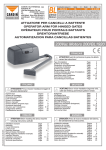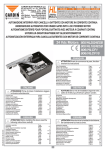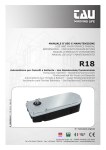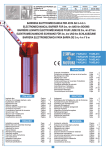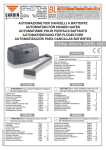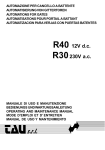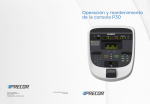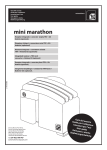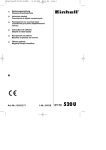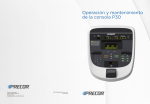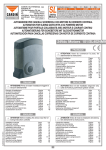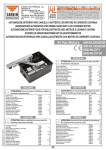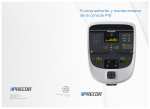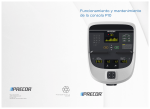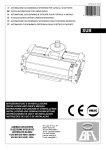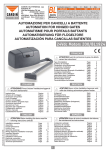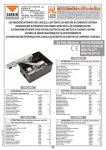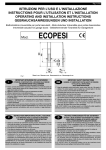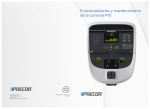Download 5 - ADI
Transcript
CARDIN ELETTRONICA spa Via Raffaello, 36 31020 San Vendemiano (TV) Italy Tel: +39/0438.404011-401818 Fax: +39/0438.401831 email (Italian): [email protected] email (Europe): [email protected] Http: www.cardin.it HL 230Vac Motors Instruction manual Series Model Date ZVL254.07 HL 251-2518 10-12-2003 Questo prodotto è stato testato e collaudato nei laboratori della casa costruttrice, la quale ne ha verificato la perfetta corrispondenza delle caratteristiche con quelle richieste dalla normativa vigente. This product has been tried and tested in the manufacturer's laboratory who have verified that the product conforms in every aspect to the safety standards in force. Ce produit a été testé et essayé dans les laboratoires du fabriquant. Pour l'installer suivre attentivement les instructions fournies. Dieses Produkt wurde in den Werkstätten der Herstellerfirma auf die perfekte Übereinstimmung ihrer Eigenschaften mit den von den geltenden Normen vorgeschriebenen getestet und geprüft. Este producto ha sido probado y ensayado en los laboratorios del fabricante, que ha comprobado la perfecta correspondencia de sus características con las contempladas por la normativa vigente. AUTOMAZIONE INTERRATA PER CANCELLI A BATTENTE UNDERGROUND AUTOMATION FOR HINGED GATES AUTOMATISME enterre POUR PORTAILS BATTANTS UNTERFLUR-DREHTORANTRIEBE AUTOMATIZACIÓN ENTERRADA PARA CANCILLAS BATIENTES 230Vac Motors 800/HL251CL 800/HL2518CL 806/HLCF1 806/HLCF18 FRANÇAIS ATTENTION! Avant de commencer la pose, lire attentivement les instructions! Type d’installation Schéma de montage Dimensions d’encombrement Contraintes d’utilisation Exemples de montage Réglage du fin de course Schéma électrique (exemple d’installation) Consignes importantes Instructions pour l’utilisation Instructions pour l’installation Branchement électrique Déverrouillage manuel Caractéristiques techniques ITALIANO ENGLISH ENGLISH ACHTUNG! Bevor mit der Installation begonnen wird, sollte die Anleitung aufmerksam gelesen werden. Pagina Pagina Pagina Pagina Pagina Pagina Pagina Pagina Pagina Pagina Pagina Pagina Pagina Anlagenart Montageschemen Aussenabmessungen Anwendungsgrenzen Installationsbeispiele Einstellung des mechanischen Endanschlages Elektrischer Schaltplan (Anlagenart) Wichtige Hinweise Betriebsanleitungen Installationsanleitungen Elektrischer Anschluss Manuelle Entriegelung Technische Daten 2 3-4 5 5 6 7 8 9 9 9 10 10 20 ZVL254.07 Mod: 27-09-2007 Seite Seite Seite Seite Seite Seite Seite Seite Seite Seite Seite Seite Seite 2 3-4 5 5 6 7 8 15 15 15 16 16 20 ESPAÑOL ATTENTION! Before installing this device read the following instructions carefully! Installation example Assembly Overall dimensions Limits of use Installation examples Adjusting the travel limit Wiring diagram (installation example) Important remarks User instructions Installation instructions Electrical connection Manual release mechanism Technical specifications 2 3-4 5 5 6 7 8 13 13 13 14 14 20 DEUTSCH ATTENZIONE! Prima di iniziare l'installazione leggere le istruzioni attentamente! Impianto tipo Schemi di montaggio Dimensioni d’ingombro Limiti d’impiego Esempi d’installazione Regolazione finecorsa Schema elettrico (impianto tipo) Avvertenze importanti Istruzioni per l’uso Istruzione per l’installazione Collegamento elettrico Sblocco manuale Caratteristiche tecniche Page Page Page Page Page Page Page Page Page Page Page Page Page Page Page Page Page Page Page Page Page Page Page Page Page Page ¡ATENCIÓN! Antes de iniciar la instalación del sistema, leer atentamente las instrucciones. 2 3-4 5 5 6 7 8 11 11 11 12 12 20 Instalación estándar Esquemas de montaje Dimensiones máximas Límites de empleo Ejemplos de instalación Regulación del tope mecánico Esquema eléctrico (instalación estandar) Advertencias importantes Instrucciones para el uso Instrucciones para la instalación Conexión eléctrica Desbloqueo manual Datos técnicos 1 Pàgina Pàgina Pàgina Pàgina Pàgina Pàgina Pàgina Pàgina Pàgina Pàgina Pàgina Pàgina Pàgina 2 3-4 5 5 6 7 8 17 17 17 18 18 20 1 Description : prodotti Technocity (lamp. fotocellule ecc.) INSTALLAZIONE TIPO HL2524 4 5 8 1 3 7 6 11 LEGENDA 1 Motoriduttore (SX) 2 Motoriduttore (DX) 12 3 Fotocellula interna 4 Fotocellula esterna 5 Lampeggiatore 6 Selettore a chiave 7 Elettroserratura 8 Antenna esterna (Cavo coassiale RG58 Impedenza 50Ω) 9 Interruttore onnipolare con apertura contatti min. 3 mm 10 Cavo alimentazione principale 230 Vac 11 Canalatura per cavo 6 metri 230 Vac 12 Canalatura per collegamenti a bassa tensione 13 Programmatore elettronico Attenzione: Lo schema rappresentato è puramente indicativo e viene fornito come base di lavoro al fine di consentire una scelta dei componenti elettronici Cardin da utilizzare. Detto schema non costituisce pertanto vincolo alcuno per l'esecuzione dell'impianto 2 23 13 10 0V -50 Hz 9 LEGEND 1 Geared motor (SX - left) 2 Geared motor (DX - right) 3 Internal photocells 4 External photocells 5 Warning lights 6 Mechanical selector switch 7 Electric locking device 8 External antenna (RG58 coaxial cable - impedance 50Ω) 9 All-pole circuit breaker with a minimum of 3 mm between the contacts 10 Mains cable 230 Vac 11 Channelling for the 6 metre cable 230V 12 Channelling route for low voltage wires 13 Electronic programmer Attention: The drawing is purely indicative and is supplied as working base from which to choose the Cardin electronic components making up the installation. This drawing therefore does not lay down any obligations regarding the execution of the installation. Zeichenerklärung 1 Getriebemotor (SX - links) 2 Getriebemotor (DX - rechts) 3 Interne Lichtschranke 4 Externe Lichtschranke 5 Blinklicht 6 Schlüsselschalter 7 Elektroverriegelung 8 Antenne (Koaxialkabel RG58 Impedanz 50Ω) 9 Allpoliger Schalter mit Kontaktenabstand von mindestens 3 mm 10 Hauptversorgungskabel 230 Vac 11 Kanalverlauf für 6-Meter-Verbindungskabel 230 Vac 12 Kanalverlauf für Anschluss auf Niederspannung 13 Elektronische Steuereinheit NOMENCLATURE 1 Motoréducteur (SX - gauche) 2 Motoréducteur (SX - droit) 3 Cellule photoélectrique intérieure 4 Cellule photoélectrique extérieure 5 Clignoteur 6 Sélecteur à clé 7 Serrure électrique 8 Antenne (Câble coaxial RG58 - Impédance 50Ω) 9 Interrupteur omnipolaire avec ouverture des contacts d'au moins 3 mm. 10 Câble d’alimentation principale 230 Vac 11 Chemin de câble 6 m 230 Vac 12 Chemin pour branchement basse tension 13 Armoire électronique Attention: le schéma, diffusé à titre purement indicatif, est destiné à vous aider dans le choix des composants électroniques Cardin à utiliser. Par conséquent, il n'a aucune valeur obligatoire quant à la réalisation de l'installation. LEYENDA 1 Motorreductor (SX - izquierda) 2 Motorreductor (SX - derecha) 3 Fotocélula interior 4 Fotocélula exterior 5 Relampagueador 6 Selector con llave 7 Electrocerradura 8 Antena exterior (Cable coaxial RG58 Impedancia 50Ω) 9 Interruptor omnipolar con apertura entre los contactos de 3 mm. como mínimo. 10 Cable de alimentación principal 230 Vac 11 Canaleta para cable 6m 230 Vac 12 Canaleta para el conexionado a baja tensión 13 Centralita electrónica Atención: La pantalla que se muestra es sólo indicativa y se suministra como base de trabajo, con el fin de permitir una elección de los componentes electrónicos Cardin por utilizar; en consecuencia, dicho esquema no constituye vínculo alguno para la ejecución del sistema. Achtung: Bei dem dargestellten Plan handelt es sich nur um ungefähre Angaben und er wird als Arbeitsgrundlage geliefert, um eine Auswahl der zu benutzenden elektronischen Komponenten von Cardin zu erlauben. Der besagte Plan ist daher für die Ausführung der Anlage nicht bindend. 2 All rights reserved. Unauthorised copying or use of the information contained in this document is punishable by law Drawing number : DI0447 Date :31-08-2006 Product Code : HL2524 Draft : P.J.Heath ESEMPIO D'INSTALLAZIONE - Installation example - Exemple d'installation - Anlagenart - INSTALACIÓN ESTÁNDAR All rights reserved. Unauthorised copying or use of the information contained in this document is punishable by law SCHEMA DI MONTAGGIO motoriduttore - GEARED MOTOR ASSEMBLY - SCHÉMA DE MONTAGE DU motorÉduCtor MONTAGEschema getriebemotor - ESQUEMA DE MONTAJE motorreductor 800/HL251CL 2 F P H M L N E AT T E N Z I O N E ! - AT T E N T I O N ! - AT T E N T I O N ! - A C H T U N G ! - ¡ C U I D A D O ! Prima di collocare la cassetta all'interno dello scavo e di avvolgerla di calcestruzzo inserire le 6 viti "E" con testa tonda nelle rispettive sedi quadre ricavate sul fondo della cassetta, come indicato, e fissarle utilizzando dadi e rondelle in dotazione che poi serviranno per il fissaggio del motoriduttore. Description : Accessori per l'interrato (sphere) Drawing number : DM378 Before placing the embedding case inside the excavation and covering it with concrete, make sure you have inserted the 6 round-headed screws "E" Code :square HL251 intoProduct their respective holes on the bottom of the case and fastened them down using the supplied nuts and washers as shown in the drawing. HL251 P.J.Heath Draft Avant de :placer le caissonDate dans :le17-11-98 puits bétonné et de le sceller avec du béton, introduire les 6 vis "E" à tête ronde dans les perforations carrées, pratiquées fond du caisson, comme indiqué figure, et les serrer fond en utilisant les écrous et les rondelles fournis en dotation et prévus pour CARDINau ELETTRONICA S.p.A - 31020 San en Vendemiano (TV) Italy à- via Raffaello, 36 Tel: 0438/401818 Fax: 0438/401831 bloquer successivement le motoréducteur. Bevor das Gehäuse in die Aushebung gelegt und mit Beton umgossen wird, müssen die 6 Rundkopf-Schrauben "E" in die entsprechenden Vierkantlöcher im Gehäuseboden wie aufgezeigt eingesetzt und mit den mitgelieferten Muttern und Unterlegscheiben befestigt werden. Diese Schrauben dienen später für die Befestigung des Getriebemotors. Antes de colocar la caja dentro de la excavación y rodearla de hormigón, introducir los 6 tornillos "E" con cabeza redonda en los alojamientos cuadrados correspondientes, conseguidos en el fondo de la caja, según lo que está indicado, y fijarlos utilizando las tuercas y arandelas suministradas que luego servirán para fijar el motorreductor. 3 SCHEMA DI MONTAGGIO motoriduttore - GEARED MOTOR ASSEMBLY - SCHÉMA DE MONTAGE DU motorÉduCtor MONTAGEschema getriebemotor - ESQUEMA DE MONTAJE motorreductor All rights reserved. Unauthorised copying or use of the information contained in this document is punishable by law 800/HL2518CL A B 3 C P S Q N P R D Q F G L E Description : Accessori per l'interrata Drawing AT T E N Z Inumber O N E: DM324 ! - AT T E N T I O N ! - AT T E N T I O N ! - A C H T U N G ! - ¡ C U I D A D O ! HL251 Product Code : HL251 Prima di collocare la cassetta all'interno dello scavo e di avvolgerla di calcestruzzo inserire le 6 viti "E" con testa tonda nelle rispettive sedi quadre rica: 30-11-98 vate sul fondo cassetta,Date come indicato, e fissarle utilizzando dadi e rondelle in dotazione che poi serviranno per il fissaggio del motoriduttore. P.J.Heath Draft :della CARDIN ELETTRONICA S.p.A - 31020 San Vendemiano (TV) Italy - via Raffaello, 36 Tel: 0438/401818 Fax: 0438/401831 Before placing the embedding case inside the excavation and covering it with concrete, make sure you have inserted the 6 round-headed screws "E" into their respective square holes on the bottom of the case and fastened them down using the supplied nuts and washers as shown in the drawing. Avant de placer le caisson dans le puits bétonné et de le sceller avec du béton, introduire les 6 vis "E" à tête ronde dans les perforations carrées, pratiquées au fond du caisson, comme indiqué en figure, et les serrer à fond en utilisant les écrous et les rondelles fournis en dotation et prévus pour bloquer successivement le motoréducteur. Bevor das Gehäuse in die Aushebung gelegt und mit Beton umgossen wird, müssen die 6 Rundkopf-Schrauben "E" in die entsprechenden Vierkantlöcher im Gehäuseboden wie aufgezeigt eingesetzt und mit den mitgelieferten Muttern und Unterlegscheiben befestigt werden. Diese Schrauben dienen später für die Befestigung des Getriebemotors. Antes de colocar la caja dentro de la excavación y rodearla de hormigón, introducir los 6 tornillos "E" con cabeza redonda en los alojamientos cuadrados correspondientes, conseguidos en el fondo de la caja, según lo que está indicado, y fijarlos utilizando las tuercas y arandelas suministradas que luego servirán para fijar el motorreductor. 4 Dimensioni d’ingombro - External dimensions - Dimensions d’encombrement AuSSenabmessungen - DIMENSIONES MAXIMAS 64 366 4 43 12 55 100 159 59 55 25 All rights reserved. Unauthorised copying or use of the information contained in this document is punishable by law 401 332 LIMITI D’IMPIEGO - limits of use - CONTRAINTES D'UTILISATION - ANWENDUNGSGRENZEN - LIMITES DE EMPLEO 5 1 1 SCALA: Description : Prodotti Technocity Drawing number : DI0104 Dimensioni d'ingombro Product Code : HL Draft : P.J.Heath Date : 19-11-98 CARDIN ELETTRONICA S.p.A - 31020 San Vendemiano (TV) Italy - via Raffaello, 36 Tel: 0438/401818 Fax: 0438/401831 1 140 140 1 180 180 SCALA: 5 ESEMPIO D’INSTALLAZIONE - INSTALLATION EXAMPLE - EXEMPLE D'INSTALLATION INSTALLATIONS BEISPEIL - EJEMPLO DE INSTALACIÓN 6 D 64mm All rights reserved. Unauthorised copying or use of the information contained in this document is punishable by law F G 3mm I B C E A SCALA: 332 332 Description : Prodotti Technocity Drawing number : DI0106 Scavo per cassa di fondazione Product Code : HL Draft : P.J.Heath Date : 19-11-98 401 401 CARDIN ELETTRONICA S.p.A - 31020 San Vendemiano (TV) Italy - via Raffaello, 36 Tel: 0438/401818 Fax: 0438/401831 3 64 159 100 59 64 6 MONTAGGIO DISPOSITIVO 180° - ASSEMBLING THE 180° DEVICE - MONTAGE DU DISPOSITIF 180° MONTAGE VORRICHTUNG 180° - MONTAJE DISPOSITIVO 180° 7 Pos. 0° Pos. 180° Z W x REGOLAZIONE FINECORSA MECCANICI - ADJUSTING THE MECHANICAL TRAVEL LIMITS - RÉGLAGE DES FINS DE COURSE MÉCANIQUES - EINSTELLUNG DES MECHANISCHEN ENDANSCHLAGES - REGULACIÓN TOPES MECANICOS R ved. Unauthorised copying or use of the information contained in Unauthorised this documentcopying is punishable law information contained 8 All rights reserved. or use by of the in this doc T M N Drawing number : DM325 Product Code : HL251 S Draft : P.J.Heath Description : Accessori per l'interrata (FIG.2) HL251 T Date : 08-01-98 CARDIN ELETTRONICA S.p.A - 31020 San Vendemiano (TV) Italy - via Raffaello, 36 Tel: 0438/401818 Fax: 0438/401831 SBLOCCO MANUALE - MANUAL RELEASE MECHANISM - DÉVERROUILLAGE MANUEL MANUELLE ENTRIEGELUNG - DESBLOQUEO MANUAL 9 Q O J H SCALA: Drawing number : 7 Description : Prodotti Technocity SCHEMA ELETTRICO IMPIANTO TIPO - STANDARD WIRING DIAGRAM - SCHÉMA ÉLECTRIQUE DE L'EXEMPLE All rights reserved. Unauthorised copyingSCHALTPLAN or use of the information contained in this ELECTRICO document is INSTALACIÓN punishable by law D'INSTALLATION - ELEKTRISCHER ANLAGENART - ESQUEMA ESTANDAR 10 13 C LC 230V~ LP 230V~ PONTICELLI NC 19 NC 20 FCC_2 FCA_2 FCC_1 NC 18 NC 21 22 ELS LINE 230V~ 28 29 30 31 32 33 34 35 N F 36 37 38 OUT 24V3W 12V15W 24V 23 24 25 26 40 17 COMUNE NA 16 COMUNE C 15 LS M1 C 39 FCA_1 27 OUT CH2 M2 14 CHIUSURA 12 COMUNE 11 APERTURA NC NC 10 CHIUSURA NC 9 FTC_S 8 FTC_I 7 NA 6 COMUNE NA 5 COMUNE NA 4 PRG811 COMUNE 3 TB LD8 APERTURA 2 TD COMUNE NA 1 TC COMUNE TAL TA ANTENNA COMUNE CSER LD1 LD2 LD3 LD4 LD5 LD6 LD7 41 PONTICELLI 1 3 2 3 24V 12V CHIUSURA APERTURA 2 COMUNE 1 4 5 0 NA x-SELL C 2 1 3 1 2 2 0 12V 24V NA NC C1(10µF) 1 6 C x-CELL Tx xLSE01-1 x-LAMP NC C2 (10µF) x-CELL Rx M1 M2 1 2 3 3 2 1 Drawing number : DI0112 Description : Programmatore a microcontrollore per 1-2 motori Product Code : BL COLLEGAMENTO SERIE HL Date : 25-11-98 P.J.Heath Draft :Terra di protezione Earth wire Terre de protection Sicherheitserdung CARDIN ELETTRONICA S.p.A - 31020 San Vendemiano (TV) Italy - via Raffaello, 36 Tel: 0438/401818 Fax: 0438/401831 Tierra 2 Grigio - Comune Grey - Common Gris - Commun Grau - Gemeinsam Gris - Común 3 Marrone - Apre Brown - Open Marron - Ouvre Braun - Öffnen Marrón - Apertura 1 Nero - Chiude Black - Close Noir - Ferme Schwarz - Schließen Negro - Cierre 1 Nero - Apre Black - Open Noir - Ouvre Schwarz - Öffnen Negro - Apertura 3 Marrone - Chiude Brown - Close Marron - Ferme Braun - Schließen Marrón - Cierre M1 M2 8 Avvertenze importanti Avvertenze importanti Avvertenze importanti PER RIDURRE IL RISCHIO DI FERITE GRAVI O MORTE, LEGGERE ATTENTAMENTE LE SEGUENTI AVVERTENZE PRIMA DI PROCEDERE ALL’INSTALLAZIONE. PRESTARE PARTICOLARE ATTENZIONE A TUTTE LE SEGNALAZIONI DISPOSTE NEL TESTO. IL MANCATO RISPETTO DI QUESTE POTREBBE COMPROMETTERE IL BUON FUNZIONAMENTO DEL SISTEMA. Descrizione tecnica 800/HL251CL Motoriduttore irreversibile, apertura anta max 110°. 806/HLCF1Z Cassa di fondazione in acciaio zincato con leve per apertura anta max 110° 806/HLCF1 Cassa di fondazione in acciaio zincato con trattamento a cataforesi e leve per apertura anta max 110° 800/HL2518CL Motoriduttore irreversibile, apertura anta 180°-360° 806/HLCF18Z Cassa di fondazione in acciaio zincato con accessori per apertura anta 180°-360° 806/HLCF18 Cassa di fondazione in acciaio zincato con con trattamento a cataforesi ed accessori per apertura anta 180°-360° 806/HLCA140 Kit leva accessoria per apertura a 140° • Monoblocco motoriduttore; - Motore monofase con protezione termica incorporata e riduttore irreversibile montato su cassa in pressofusione di alluminio con lubrificazione a grasso fluido permanente. - Guarnizioni in gomma a tenuta d'olio; - Sblocco manuale a chiave. • Cassetta da interrare in acciaio pressopiegato, zincato a caldo; - Scatola sblocco in alluminio pressofuso. • Leve di trasmissione in acciaio zincato; - Staffa di fissaggio cancello in acciaio zincato. • Il presente manuale si rivolge a persone abilitate all'installazione di "APPARECCHI UTILIZZATORI DI ENERGIA ELETTRICA" e richiede una buona conoscenza della tecnica, esercitata in forma professionale e della normativa vigente. I materiali usati devono essere certificati e risultare idonei alle condizioni ambientali di installazione. • Le operazioni di manutenzione devono essere eseguite da personale qualificato. Prima di eseguire qualsiasi operazione di pulizia o di manutenzione, disinserire l'apparecchiatura dalla rete di alimentazione elettrica. • Le apparecchiature qui descritte dovranno essere destinate solo all'uso per il quale sono state espressamente concepite: "La motorizzazione di cancelli a battente ad una o due ante". Il dispositivo è destinato alla motorizzazione di cancelli e portoni con ante battenti fino a 3 m max con le seguenti caratteristiche: - peso massimo per anta 2-3 m = 550 kg - peso massimo per anta meno di 2 m = 700 kg • L'applicazione è possibile sia a sx che a dx della luce passaggio. • Questo prodotto è stato progettato e fabbricato in tutte le sue parti a cura della Cardin Elettronica la quale ne ha verificato la perfetta corrispondenza delle caratteristiche con quelle richieste dalla normativa vigente. ISTRUZIONI PER L'INSTALLAZIONE L'utilizzo dei prodotti e la loro destinazione ad usi diversi da quelli previsti e/o consigliati, non è stata sperimentata dal costruttore, pertanto i lavori eseguiti sono sotto la completa responsabilità dell'installatore. I comandi minimi che possono essere installati sono APERTURA-STOPCHIUSURA, tali comandi devono essere posti in un luogo non accessibile a bambini o minori e fuori dal raggio d’azione del cancello. Prima di procedere all'esecuzione dell'impianto verificare che la struttura da automatizzare sia in perfetta efficienza nelle sue parti fisse e mobili e realizzata in conformità alla normativa vigente. A tal fine accertarsi della sufficiente rigidità del telo cancello (se necessario intervenire con rinforzi sulla struttura) e del buon funzionamento dei perni (si consiglia comunque di lubrificare tutte le parti in movimento usando lubrificanti che mantengano uguali caratteristiche di attrito nel tempo e adatti a funzionare tra -20 e +70°C). L'uso dell'automazione non è idoneo all'azionamento in continuo, bensì deve essere contenuto entro il valore riportato in tabella (vedi caratteristiche tecniche pagina 20). Il costruttore non risponde qualora l'impianto elettrico non risulti conforme alle norme vigenti ed in particolare qualora il circuito di protezione (terra) non sia efficiente. CONSIDERAZIONI GENERALI DI SICUREZZA È responsabilità dell’installatore verificare le seguenti condizioni di sicurezza: 1)L’installazione deve essere sufficientemente lontana dalla strada in modo da non costituire pericolo per la circolazione. • Controllare i franchi di sicurezza tra parti fisse e parti mobili: - lasciare uno spazio di 30 mm minimo tra il cancello ed il pilastro di supporto per tutta l’altezza e per tutto l’arco di apertura del cancello; - assicurarsi che lo spazio tra il cancello ed il pavimento non superi mai 30 mm per tutto l’arco di apertura del cancello. • La superficie delle ante non deve presentare aperture tali da permettere il passaggio della mano o del piede di persone. • Controllare l'esatto posizionamento di perni e cerniere, il loro buono stato di mantenimento e lubrificazione (è importante che la cerniera superiore e quella inferiore siano a piombo tra loro). • Prevedere il percorso dei cavi secondo le necessità di applicazione dei dispositivi di comando e sicurezza (vedi impianto tipo fig.1 pag.2). • Controllare che l’operatore sia proporzionato alle dimensioni del cancello e alla frequenza d’uso (intermittenza di lavoro, pag. 20). 2)L’operatore deve essere installato all’interno della proprietà ed il cancello non deve aprirsi verso l’area pubblica. 3)Il cancello motorizzato é principalmente adibito al passaggio di vetture. Dove possibile installare per pedoni un ingresso separato. 4)I comandi devono essere posti in vista, ma non entro il raggio d’azione del cancello. Inoltre quelli installati all’esterno devono essere protetti da una sicurezza tale da prevenire l’uso non autorizzato. 5)È buona norma segnalare l’automazione con targhe di avvertenza (simili a quella in figura) che devono essere facilmente visibili. Qualora l’automazione sia adibita al solo passaggio di veicoli dovranno essere poste due targhe di avvertenza di divieto di transito pedonale (una all’interno, una all’esterno). 6)Rendere consapevole l’utente che bambini o animali domestici non devono giocare o sostare nei pressi del cancello. Se necessario indicarlo in targa. Procedura di montaggio - Scegliere la posizione della cassetta da interrare in base alla posizione del perno d'incernieramento del cancello rispetto al pilastro e al tipo di apertura (90°-110°-180°) da realizzare (fig. 5). - Sistemare una battuta di arresto meccanico in chiusura. - Eseguire uno scavo di fondazione "A" (fig. 6) nella posizione prescelta in base alla dimensione della cassetta e prevedere uno scarico per l'acqua piovana utilizzando il foro "B". - Prevedere il percorso della canalatura per i cavi di collegamento elettrico utilizzando il foro "C". - Inserire le sei viti con testa tonda "E" nelle rispettive sedi quadre ricavate sul fondo della cassetta e bloccarle utilizzando le rondelle e i dadi previsti per il successivo bloccaggio del motoriduttore. 7)Qualora l’anta completamente aperta vada ad avvicinarsi ad una struttura fissa lasciando uno spazio di almeno 500 mm, tale spazio deve essere protetto con ATTENZIONE una costa sensibile antischiacciamento. 8)La bontà della connessione di terra dell’apparecchiatura è fondamentale ai fini della sicurezza elettrica. 9)Per qualsiasi dubbio a riguardo della sicurezza dell’installazione, non procedere ma rivolgersi al distributore del prodotto. APERTURA AUTOMATICA NON AVVICINARSI NON PERMETTERE A BAMBINI O AD ANIMALI DOMESTICI DI SOSTARE NEL RAGGIO D'AZIONE DEL CANCELLO 9 - Collocare la cassetta all'interno dello scavo con il perno perpendicolare rispetto al cardine superiore "D" e avvolgerla di calcestruzzo, curare la messa in bolla e la corretta posizione del bordo superiore che dovrà sporgere di 3 mm dal livello terra. - Togliere i dadi e le rondelle utilizzati per bloccare i bulloni a testa tonda sul fondo della cassetta. - Inserire il motoriduttore nella cassetta e fissarlo a quattro dei sei perni filettati "E" premontati sul fondo della stessa. - Fissare il piatto superiore "F" completo di sblocco all'anta del cancello con saldatura robusta, calcolando che il perno "G" della leva stessa deve risultare in asse col cardine superiore "D". - Quindi, a seconda del modello, procedere come segue: COLLEGAMENTO ELETTRICO (fig. 10) Assicurarsi prima di allacciare l’apparecchiatura che la tensione e la frequenza di rete corrisponda ai valori riportati nella targhetta caratteristiche. • L’apparecchiatura funziona con tensione monofase 230V 50Hz (vedi schema elettrico) • Il motoriduttore deve essere collegato ad un efficace impianto di messa a terra, pertanto utilizzare il morsetto contrassegnato con il simbolo che si trova sulla scatola riduttore. • Non utilizzare cavo con conduttori in alluminio; non stagnare l’estremità dei cavi da inserire in morsettiera; utilizzare cavo adatto ad essere interrato. • Il motoriduttore è provvisto di cavo di alimentazione lungo 6 m, prevedere se necessario una scatola di derivazione esterna per i collegamenti elettrici (pos.4 fig.1), non sono ammessi collegamenti interrati. • Mod. 800/HL251CL con cassa 806/HLCF1 - Posizionare la leva cancello "H" (fig. 2). sul perno della cassetta dopo aver ingrassato il perno stesso e inserire all'interno della leva la sfera di articolazione "L". - Montare l'anta inserendo il perno della leva "F" nella rispettiva sede della leva cancello "H" (fig. 2). dopo aver ingrassato le parti e fissare il cardine superiore "D" (fig 6). - Montare la biella di trasmissione "M" (fig. 2) tra la leva "N" del motoriduttore e la leva "H" del cancello avendo cura di ingrassare bene i perni. - Portare lentamente l'anta ad allinearsi con la leva cancello "H" (fig. 9) in modo che il meccanismo di sblocco "O" vada ad impegnarsi con lo scrocco della leva cancello "H". L’aggancio è automatico e non richiede l’uso della chiave. - Chiudere il coperchio "P" (fig. 2) con le due viti in dotazione. Tra la centralina di comando e la rete deve essere interposto un interruttore onnipolare con distanza di apertura tra i contatti di almeno 3 mm. • Collegare tra le fasi 1 e 3 del motoriduttore (fig. 10) il condensatore fornito di serie (10µF). IMPORTANTE! Il motoriduttore è sprovvisto di limitatore di coppia, pertanto utilizzare una centralina a limitazione della coppia impostando una spinta massima in punta d'anta pari a 150 N. REGOLAZIONE COPPIA MOTORE (vedi programmatore) Per la realizzazione dell'impianto si consiglia di utilizzare programmatori Cardin provvisti di regolazione della coppia. I programmatori Cardin, ottimizzano il buon funzionamento della "macchina" (portone motorizzato), garantendo allo spunto (inizio della manovra, apertura - chiusura) sempre la coppia massima erogabile. Durante tutta la manovra il programmatore garantisce al sistema la coppia selezionata dall'installatore sull'apparecchiatura. La selezione dei diversi valori viene operata in base alla dimensione, al peso dell'anta e a diverse variabili ambientali valutate in loco. Si ricorda che la normativa vigente richiede tassativamente una coppia adeguatamente regolata sull'impianto in funzione. Una coppia regolata correttamente garantisce la massima sicurezza e allunga la vita di tutti gli organi meccanici. REGOLAZIONE FINE CORSA MECCANICO (solo per mod. 800/HL251CL con cassa 806/HLCF1 - fig. 8) Il finecorsa meccanico regolabile previsto tra la leva "N" del motoriduttore e la sporgenza "R" interna alla cassetta deve essere utilizzato al fine di non caricare eccessivamente l'anta in chiusura e di permettere un regolare funzionamento del meccanismo di sblocco. Per la regolazione procedere come segue: - Portare l'anta "S" in battuta contro il fermo meccanico cancello e staccare istantaneamente l'alimentazione al motore. - Far fuoriuscire la vite "T" dalla leva "N" fino a portarla in battuta contro il fermo "R" in questo modo la biella "M" mantiene chiuso il cancello senza esercitare sforzi eccessivi su di esso. - Utilizzare la vite e dado "T" in dotazione per effettuare un fermo meccanico regolabile in apertura. SBLOCCO MANUALE (fig. 9) • Mod. 800/HL2518CL con cassa 806/HLCF18 - Togliere la squadretta "L" (fig. 3) dalla sua posizione. - Inserire la leva "A" nel relativo perno della cassetta con un po’ di grasso e quindi la sfera "G" all’interno. - Applicare la piastra tendicatena "F" alla parte superiore del motoriduttore con le viti in dotazione. - Dopo aver messo un anello seeger inferiore "Q" inserire i piatti tendicatena "N" con pignone "D" e anelli distanziali "R" nel relativo perno delle piastra "F" e fissare con un seeger superiore. - Montare le due viti di registro "P", con dado di bloccaggio, nei rispettivi fori M5 dei piatti "N" . - Montare anche l’altro pignone "D" con relativo perno "S" e anelli distanziali "R" nel foro asolato, facendo entrare le viti "P" nelle relative sedi del perno "S". - Montare la catena "B" facendo aderire una sua estremità in posizione "Z" (fig. 7) ai denti della corona della leva "A" (fig. 3). Leva cancello "A" in posizione 0° (fig. 7). - Ruotare la leva di 180°, in tal modo l’estremità posizione "Z" della catena verrà trascinata in posizione "W" così da poter essere collegata all’altra estremità tramite la maglia di giunzione "C" (fig. 3). - Tendere la catena agendo sulle viti di registro. Per eseguire tale operazione si consiglia di portare l’anta in battuta meccanica nella posizione di 0° azionando il motoriduttore, così facendo si mette in tiro il lato "X" e si scarica il lato "W" (fig. 7) della catena e sarà facilitato l’azzeramento dei giochi. Serrare bene i dadi di bloccaggio "P" (fig. 3). - Riposizionare la squadretta "L" nella sua posizione iniziale. - È buona norma ingrassare catena e perni periodicamente. - Portare lentamente l'anta ad allinearsi con la leva cancello "H" (fig. 9) in modo che il meccanismo di sblocco "O" vada ad impegnarsi con lo scrocco della leva cancello "H". L’aggancio è automatico e non richiede l’uso della chiave. - Chiudere il coperchio "P" (fig. 3) con le due viti in dotazione. L'operazione di sblocco va fatta solamente a motore fermo, per mancanza di energia elettrica. Munirsi della chiave in dotazione all’apparecchiatura. Essa deve essere conservata in luogo di facile reperimento. Per sbloccare l’anta - Spostare lo sportellino "Q" (fig. 9) copriserratura. - Inserire la chiave e ruotare di mezzo giro (180°), lo sgancio sarà immediato.Tale operazione rende l’anta folle rispetto al meccanismo e quindi libera di ruotare manualmente. - Aprire l’anta esercitando una leggera spinta. Per ribloccare l’anta - Portare lentamente l’anta ad allinearsi con la leva cancello "H" in modo che il meccanismo di sblocco "O" vada ad impegnarsi con lo scrocco della leva cancello "H". Il riaggancio è automatico e non richiede l’uso della chiave. - È anche possibile fare ripartire il motoriduttore, il quale si andrà a riagganciare automaticamente all’anta. ISTRUZIONI PER L'USO Durante la manovra si deve controllare il movimento del cancello e azionare il dispositivo di arresto immediato (STOP) in caso di pericolo. In caso di emergenza il cancello può essere sbloccato manualmente utilizzando l'apposita chiave di sblocco in dotazione (vedi sblocco manuale). Controllare periodicamente lo stato di usura dei perni ed eventualmente ingrassare le parti in moto, usando lubrificanti che mantengano uguali caratteristiche di attrito nel tempo e adatti a funzionare tra -20 e +70°C (in particolare la leva sblocco che è munita di apposito ingrassatore "J" fig. 9). In caso di guasto o anomalie di funzionamento staccare l'alimentazione elettrica a monte dell'apparecchiatura e chiamare l'assistenza tecnica. Verificare periodicamente il funzionamento delle sicurezze (fotocellule ecc.) Le eventuali riparazioni devono essere eseguite da personale specializzato usando materiali originali e certificati. 10 IMPORTANT REMARKS IMPORTANT REMARKS IMPORTANT REMARKS TO REDUCE THE RISK OF SEVERE INJURY OR DEATH READ THE FOLLOWING REMARKS CAREFULLY BEFORE PROCEEDING WITH THE INSTALLATION. PAY PARTICULAR ATTENTION TO ALL THE PARAGRAPHS MARKED WITH THE SYMBOL . NOT READING THESE IMPORTANT INSTRUCTIONS COULD COMPROMISE THE CORRECT WORKING ORDER OF THE SYSTEM. Technical description 800/HL251CL Reversible geared motor, maximum opening 110°. 806/HLCF1 Embedding case in zinc plated steel with cataphoresis finishing and a transmission lever for 110°. 806/HLCF1Z Embedding case in zinc plated steel with transmission lever for 110°. 800/HL2518CL Reversible geared motor, gate opening 118°-360°. 806/HLCF18 Embedding case in zinc-plated steel with cataphoresis finishing and accessories for gate opening 110°-360°. 806/HLCF18Z Embedding case in zinc-plated steel with accessories for gate opening 110°-360°. 806/HLCA140 Kit of lever accessories for a 140° opening angle. • Single piece geared reduction unit; - Single phase drive motor with an incorporated overload protector and a permanently lubricated reversible reduction unit mounted on a cast iron stator. - Rubber sealing gasket; - Key operated manual release mechanism. • Embedding case in hot rolled zinc-plated steel; - Release unit housing in pressed aluminium. • Transmission levers in zinc-plated steel; - Gate fastening bracket in zinc-plated steel. • These instructions are aimed at professionally qualified "INSTALLERS OF ELECTRICAL EQUIPMENT" and must respect the local standards and regulations in force. All materials used must be approved and must suit the environment in which the installation is situated. • All maintenance operations must be carried out by professionally qualified technicians. Before carrying out any cleaning or maintenance operations make sure the power is disconnected at the mains. • This appliance must be used exclusively for the purpose for which it has been made. "i.e. for the automation of one or two hinged gates". The appliance may be used to operate hinged gates and doors, with gate leaves up to 3 m in length and the following characteristics: - maximum weight for 2-3 m long gates = 550 kg - maximum weight for gates less than 2 m long = 700 kg • The unit may be fitted both to the right and to the left of the passageway. • This product and all its relative components has been designed and manufactured by Cardin Elettronica who have verified that the product conforms in every aspect to the safety standards in force. Any non authorised modifications are to be considered improper and therefore dangerous. USER INSTRUCTIONS The manufacturer accepts no liability for situations arising from the use of an electrical installation which does not conform to the local standards and regulations in force and in particular when the earthing circuit is not efficient. The minimum controls which may be installed are OPEN-STOP-CLOSE, these controls must be installed in a location not accessible to children. Before starting with the installation of the system check that the structure which is to be automated is in good working order and respects the local standards and regulations in force. To this end make sure that the gate is sufficiently rigid (if necessary reinforce the structure) and that the hinges turn easily. You are advised to grease all the moving parts using lubricants which maintain unaltered friction characteristics over a period of time and are suitable for temperatures of -20 to +70°C. The appliance is not suitable for continuous operation and must be contained within the value stipullated (see technical data on page 20). IMPORTANT SAFETY INSTRUCTIONS It is the responsibility of the installer to make sure that the following public safety conditions are satisfied: 1)Ensure that the gate operating installation is far enough away from the main road to eliminate possible traffic disruptions. • Check the safety measures between the fixed and moving parts: - a minimum space of 30 mm must always be left along the entire distance between the gate and the support column measured throughout the entire opening angle of the gate. - make sure that the space between the bottom of the gate and the pavement never exceeds 30 mm throughout the entire opening angle of the gate. • The surface of the gate must not feature openings which allow a person’s hand or foot to pass through. • Check the exact positioning of the pivots and hinges, and their good working order (the upper and lower hinges/pivots must be aligned on the same axis). • Work out the run of the cables according to the command and control devices fitted and make sure the system conforms to the local standard and regulations in force (see installation example fig.1 pag. 2). • Check that the appliance is suitable for the size, weight and duty cycle of the gate to which it is to be applied (see duty cycle on page 20). 2)The operator must be installed on the inside of the property and not on the public side of the gate. The gates must not swing outwards onto a public area. 3)The gate operator is designed for use on gates through which vehicles are passing. Pedestrians should use a separate entrance. 4)The gate must be in full view when it is operating therefore controls must be situated in a position where the operator can see the gate at all times. 5)At least two warning signs (similar to the example on the right) should be placed, where they can be easily seen by the public, in the area of the system of automatic operation. One inside the property and one on the public side of the installation. These signs must be indelible and not hidden by any objects (such as tree branches, decorative fencing etc.). 6)Make sure that the end-user is aware that children and/or pets must not be allowed to play within the area of a gate installation. If possible include this in the warning signs. 7)Whenever a fully open gate leaf comes within at least 500 mm of a fixed structure the space must be protected by an anticrush buffer. WARNING AUTOMATIC OPENING 8)A correct earth connection is fundamental in kEEP CLEAR order to guarantee the electrical safety of the machine 9)If you have any questions about the safety of the gate operating system, do not install the operator. Contact your dealer for assistance. FITTING THE UNIT - Choose the ideal position for the foundation case according to the opening angle (90°-110°-180° fig. 5) and the position of the gate pivot. - Place a mechanical travel buffer in the closing direction. - Dig the foundation hole "A" (fig. 6) sufficiently large to house the foundation case and run a drain channel up to the hole "B". - Run the channelling for the cables up to the hole "C". - Insert the six round headed screws "E" into the holes on the bottom of the case and fasten down using the supplied nuts and washers. CHILDREN OR PETS MUST NOT BE ALLOWED TO PLAY ON OR NEAR THE INSTALLATION 11 - Place the foundation case in the hole with the pin perpendicular to the upper gate pivot "D", cover the case in concrete and check that it is in square and that the upper edge protrudes by at lkeast 3 mm from the ground. - Remove the nuts and washers used to fasten down the round headed bolts in the embedding case. - Insert the motor reduction unit and fasten down using four of the six threaded bolts "E" located underneath the motor. Weld the upper bar "F" complete with release mechanism to the gate remembering that the pin "G" of the lever must be in line with the upper gate pivot "D" (fig. 5). - At this point proceed according to your model as follows: ELECTRICAL CONNECTION (fig. 10) Before connecting the appliance make sure that the voltage and frequency rated on the data plate conform to those of the mains supply. • The appliance works off a single phase 230V 50Hz power supply (see wiring diagram). • The geared motor must be earthed, to this end use the binding post marked which can be found on the geared motor. • Do not use cables with aluminium conductors; do not solder the ends of cables which are to be inserted into the binding posts; use cables which are suitable for embedding. • The motor is fitted with a standard 6m long cable which may require external shunt boxes (pos. 4 fig.1) for the electrical connection. The cable must never be embedded. • Mod. 800/HL251CL with embedding case 806/HLCF1 - Position the gate lever "H" (fig. 2) on the case pin after having first greased the pin and then insert the ball bearing "L" inside the lever. - Mount the gate leaf by inserting the pin of the lever "F" into its housing on the gate lever "H" (fig. 2) after having first greased the moving parts and then position the upper hinge "D" (fig. 6). - Mount the transmission rod "M" (fig. 2) between the motor reduction lever "N" and the gate lever "H" after having first greased the moving parts. - Align the gate leaf slowly with the gate lever "H" (fig. 9) so that the manual release mechanism "O" slots into the seat in the gate lever "H". The connection between the two parts is automatic and does not require the use of the key. - Fit the cover "P" (fig. 2). using the two supplied screws. An all pale circuit breaker with a minimum of 3 mm between the contacts must be installed between the electronic programmer and the mains supply. • Connect the supplied capacitor (10µF) between the live wires 1 and 3 of the geared motor (fig. 10). IMPORTANT! The geared motor is not fitted with a torque limiter. Only use an electronic programmer which has a torque limiter with maximum force at the head of the gate equal to 150N (local standards and regulations in force). SETTING THE MOTOR TORQUE (see electronic programmer) MECHANICAL TRAVEL LIMIT ADJUSTMENT (Mod. 800/HL251CL with embedding case 806/HLCF1- fig. 8) When carrying out the installation you are advised to use a Cardin electronic programmer fitted with a torque limiter. The Cardin programmers optimise the correct working order of the "machine" (motorised gates/doors) and guarantee full power maximum thrust at the start of the opening/closing manoeuvre). The programmer also guarantees that the effective torque fed to the system will be that selected by the operator in the electronic programmer. The choice of settings depends on the weight and size of the gate leaf/door and the different environmental conditions on-site. You are reminded that the standards and regulations in force unequivocally require that the torque be set to a level suitable for the system. Correctly choosing the torque will guarantee maximum security and long life for the mechanical components. The adjustable travel limit placed between the lever "N" of the geared motor and the outcrop "R" inside the case is used to avoid excessively overloading the gate in the closing direction and to allow the regular operation of the gate. To adjust the mechanism proceed as follows: - Move the gate leaf "S" until it rests up against the the mechanical gate block and then switch off the power supply. - Turn the screw "T" of the lever all "N" until it rests up tight against the block "R" in this way the transmission rod "M" will keep the gate closed without forcing it. - Use the supplied nut and screw "T" to enable a manual mechanical travel limit for the opening direction. • Mod. 800/HL2518CL with embedding case 806/HLCF18 MANUAL RELEASE MECHANISM (fig. 9) - Remove the bracket "L" (fig. 3). - Insert the the lever "A" into the pin on the embedding case, grease the components and then insert the ball bearing "G". - Fit the chain tightener plate to the upper side of the geared motor using the supplied screws. - Fit the chain tightener brackets "N", with the pinion "D" and spacer washers "R", onto the pin on the plate "F" and tighten down using the upper Seeger washer, after having inserted the lower Seeger washer "Q". - Fit the 2 adjustment screws "P", along with their lock nuts, into the M5 holes on the brackets "N". - Mount the other pinion "D", retaining pin "S" and spacer washers "R" into the oval slot and allows the screws "P" to enter into the seats on the pin "S". - Mount the chain "B" wrapping one of the ends "Z" (fig. 7) around the cog of the lever "A" (fig. 3). The gate lever "A" must be in position 0° (fig. 7). - Rotate the lever through 180° so the the end of the chain "Z" (fig. 7) is dragged to the position "W" it can then be joined to the other end using the chain joint "C" (fig. 3). - Tighten the chain by adjusting the setting screws "P". To carry out this operation you are advised to move the gate to the completely closed position "0°" by activating the geared motor. This will put the side "X" (fig. 7) under tension and relax side "W" (fig. 7) thus allowing you to adjust the play more easily. Tighten down the lock nuts "P" (fig. 3). - Replace the bracket "L" in its original position. - Grease the chain and retaining pins regularly. - Align the gate leaf slowly with the gate lever "H" (fig. 9) so that the manual release mechanism "O" slots into the seat in the gate lever "H". The connection between the two parts is automatic and does not require the use of the key. - Fit the cover "P" (fig 3). using the two supplied screws. Releasing the gate should only be carried out when the motor has stopped because of blackouts. To release the gate use the key supplied with the appliance. It should be stored in an easily accessible place. To release the gate - Open the sliding key cover "Q" (fig. 9). - Insert the key and rotate it half a turn (180°), the lock will release itself immediately. This will release the geared motor and free the gate which can then be opened by pushing lightly on the gate. To block the gate - Align the gate leaf slowly with the gate lever "H" (fig. 9) so that the manual release mechanism "O" slots into the seat in the gate lever "H". The connection between the two parts is automatic and does not require the use of the key. - It is also possible to restart the geared motor which will automatically hook up to the gate. INSTALLATION INSTRUCTIONS During the opening/closing manoeuvre check for correct operation and activate the emergency stop button in case of danger. During blackouts the gate can be released and manually manoeuvred using the supplied release key (see manual release). Periodically check the moving parts for wear and tear and grease if required, using lubricants which maintain their friction levels unaltered throughout time and are suitable for temperatures of -20 to +70°C (in particular the release lever which is fitted with a greaser "J" fig. 9). In case of failure or operational anomalies switch off the power at the mains do not attempt to repair the appliance yourself. Periodically check the correct operation of all safety devices (photoelectric cells etc.) Eventual repair work must be carried out by specialised personnel using original spare parts. 12 CONSigneS IMPORTANTeS! CONSigneS IMPORTANTeS! CONSigneS IMPORTANTeS! POUR RÉDUIRE LES RISQUES DE BLESSURES GRAVES OU DE MORT, LIRE ATTENTIVEMENT LES CONSIGNES SUIVANTES AVANT DE PROCÉDER À LA POSE. PRÊTER GRANDE ATTENTION À TOUTES LES SIGNALISATIONS qui se trouvent dans le texte. LE NON RESPECT DE CES CONSIGNES POURRAIT COMPROMETTRE LE BON FONCTIONNEMENT DU SYSTÈME. Description technique 800/HL251CL Motoréducteur irréversible, ouverture de vantail 110° maxi. 806/HLCF1 Caisson de fondation en acier galvanisé traité par cataphorèse avec leviers pour une ouverture de vantail 110° maxi. 806/HLCF1Z Caisson de fondation en acier galvanisé avec leviers pour une ouverture de vantail 110° maxi. 800/HL2518CLMotoréducteur irréversible, ouverture de vantail 180°-360° 806/HLCF18 Caisson de fondation en acier galvanisé traité par cataphorèse avec accessoires pour ouverture de vantail 180°-360°. 806/HLCF18Z Caisson de fondation en acier galvanisé avec accessoires pour ouverture de vantail 180°-360°. 806/HLCA140 Kit levier accessoire pour ouverture à 140° • Monobloc motoréducteur; - Moteur monophasé avec protection thermique intégrée et réducteur irréversible sous caisson en aluminium moulé sous pression, lubrification permanente par graisse fluide. - Joints d’étanchéité à l’huile, en caoutchouc; - Déverrouillage manuel à clé. • Caisson à placer sous terre, en acier plié et galvanisé à chaud; - Boîtier de déverrouillage en aluminium moulé sous pression. • Leviers de transmission en acier galvanisé; - Étrier en acier galvanisé pour la fixation du portail. • Ce livret est destiné à des personnes titulaires d'un certificat d'aptitude professionnelle pour l'installation des "appareils électriques" et requiert une bonne connaissance de la technique appliquée professionnellement, ainsi que des normes en vigueur. Les matériels utilisés doivent être certifiés et être adaptés aux conditions atmosphériques du lieu d'implantation. • Les travaux de maintenance ne doivent être effectués que par un personnel qualifié. Avant une quelconque opération de nettoyage ou de maintenance, mettre l'appareil hors tension. • Les appareils décrits dans ce livret ne doivent être destinés qu’à l’utilisation pour laquelle ils ont été expressément conçus à savoir: "La motorisation de portails battants à un ou deux vantaux". Le dispositif est indiqué pour la motorisation de portes et portails battants de 3m maxi. par vantail avec les caractéristiques suivantes: - poids maximal par vantail 2-3 m = 550 kg - poids maximal par vantail moins de 2 m = 700 kg. • Tous les modèles sont applicables aussi bien à droite qu’à gauche du passage. • Ce produit a été étudié et construit entièrement par la Sté Cardin Elettronica qui a pris soin de vérifier la conformité de ses caractéristiques avec les exigences des normes en vigueur. INSTRUCTIONS POUR L’INSTALLATION Une diverse utilisation des produits ou leur destination à un usage différent de celui prévu et/ou conseillé n'a pas été expérimentée par le Constructeur. Par conséquent, les travaux effectués sont entièrement sous la responsabilité de l'installateur. L’organe de commande minimum requis est une boîte à boutons OUVERTURE-STOP-FERMETURE; celle-ci devra être installée impérativement hors de portée de mineurs, notamment des enfants, et hors du rayon d’action du portail. Avant de réaliser l’installation, s’assurer de l’efficacité des parties fixes et mobiles de la structure à automatiser et de la conformité de celle-ci aux normes en vigueur. Dans cet objectif, s’assurer de la rigidité du tablier du portail (si nécessaire renforcer la structure) et du bon fonctionnement des pivots (il est conseillé de graisser toutes les parties mobiles avec un lubrifiant qui maintient au fil des années les caractéristiques de friction et qui est adapté à des températures oscillant entre -20° et +70°C). L’automatisme n’est pas adapté à une activation continue; mais il doit être limité à la valeur indiquée sur le tableau (voir caractéristiques techniques page 20). Le Constructeur décline toute responsabilité en cas d'installation électrique non conforme aux normes en vigueur, notamment en cas de circuit de protection (mise à terre) inefficace. CONSIGNES GÉNÉRALES DE SÉCURITÉ Il appartient à l’installateur de vérifier les conditions de sécurité ci-dessous: • Contrôler les espaces de sécurité entre les parties fixes et mobiles: - laisser un espace de 30 mm au moins entre le vantail et le pilier de support sur toute la hauteur et sur tout l’arc d’ouverture du portail; - contrôler que l’espace entre le portail et le sol ne soit jamais supérieur à 30 mm sur tout l’arc d’ouverture du portail. • Sur la surface des vantaux il ne doit pas y avoir d’ouvertures qui permettent le passage de la main ou du pied. • Contrôler l’emplacement correct des pivots et des gonds, leur bon état et leur lubrification (le gond du haut et celui du bas doivent être parfaitement alignés). • Prévoir le parcours des câbles en fonction des dispositifs de commande et de sécurité imposés par les normes en vigueur (voir exemple d’installation fig.1 page 2). • Contrôler que l’opérateur soit adapté aux dimensions du portail et à la fréquence d’utilisation (intermittence de travail, page 20). 1)L’installation doit se trouver suffisamment loin de la route pour ne pas constituer de risque pour la circulation; 2)L’opérateur doit être installé à l’intérieur de la propriété et le portail ne doit pas s’ouvrir sur le domaine public; 3)Le portail automatisé est affecté principalement au passage de véhicules. Si possible, prévoir une entrée séparée pour les piétons; 4)Les organes de commande doivent être placés de façon qu’ils soient bien en vue et hors du rayon d’action du portail. En outre, ceux placés à l’extérieur doivent être protégés contre les actes de vandalisme; 5)Il est conseillé de signaler l’automatisation du portail par des panneaux de signalisation (comme celui indiqué en figure) placés bien en vue. Dans l’hypothèse où l’automatisme serait affecté exclusivement au passage de véhicules, il faudra prévoir deux panneaux d’interdiction de passage aux piétons (l’un à l’intérieur et l’autre à l’extérieur); NOTICE DE MONTAGE - Suivant la position du pivot de ferrure du portail par rapport au pilier et au type d’ouverture (90°-110°-180°) prévu (fig. 5), déterminer l’endroit pour enterrer le caisson. - Installer une butée d’arrêt mécanique en fermeture. - Réaliser un puits bétonné "A" (fig. 6), à l’endroit prédéterminé, en fonction de la dimension du caisson. Prévoir une canalisation pour l’évacuation des eaux pluviales à travers le trou "B". - Prévoir le passage de la conduite pour les câbles de branchement électrique par le trou "C". - Introduire les six vis "E" à tête ronde dans les perforations carrées, pratiquées au fond du caisson, comme indiqué en figure, et les serrer à fond en utilisant les écrous et les rondelles prévus pour bloquer successivement le motoréducteur. 6)Faire prendre conscience à l’utilisateur du fait que les enfants et les animaux domestiques ne doivent pas jouer ou stationner à proximité du portail. Si nécessaire, l’indiquer sur le panneau; 7) Si le vantail, une fois qu’il est complètement ouvert, se trouve très proche d’une structure fixe, laisser un espace de au moins 500 mm dans la zone d’action du bras articulé; tel ATTENTION FERMETURE AUTOMATISÉE espace devra être protégé par un bord de sécurité NE PAS S'APPROCHER anti-coincement. 8) Pour garantir la sécurité électrique, il est impératif de brancher l’appareil à la prise de terre. 9) En cas d’un quelconque doute sur la sécurité de l’installation, interrompre la pose et contacter le distributeur du matériel. NE PAS PERMETTRE AUx ENFANTS ET AUx ANIMAUx DOMESTIQUES DE STATIONNER DANS LE RAYON D'ACTION DU PORTAIL 13 - Placer le caisson dans le puits bétonné, en veillant à ce que le pivot soit placé perpendiculairement au gond supérieur "D", et le sceller avec du béton. Contrôler qu’il soit mis à niveau et que le bord supérieur soit en saillie de 3 mm par rapport au sol. - Enlever les écrous et les rondelles qui ont servi à bloquer les boulons à tête ronde sur le fond du caisson. - Placer le motoréducteur dans le caisson et le fixer à l’aide de quatre des six goujons "E" prémontés sur le fond du caisson. - Fixer le méplat supérieur "F", doté du système de déverrouillage du vantail, en le soudant soigneusement. Veiller à ce que le pivot "G" du levier même et le gond supérieur "D" soient sur le même axe. - Ensuite, en fonction du modèle, procéder de la façon suivante: BRANCHEMENT ÉLECTRIQUE (fig. 10) Avant de procéder au branchement électrique, contrôler que la tension et la fréquence du réseau d’alimentation correspondent aux données de la plaquette signalétique. • L’appareil fonctionne à une tension monophasée 230V 50 Hz (voir schéma électrique). • Le motoréducteur doit être branché à une installation efficace de mise à terre. Utiliser impérativement la borne marquée du symbole qui se trouve sur le boîtier du bornier. • Ne pas utiliser de câble avec conducteurs en aluminium; ne pas étamer l’extrémité des fils à brancher sur le bornier. Utiliser un câble adapté à être placé sous terre. - Le motoréducteur est muni d’un câble d’alimentation d’une longueur de 6 m. Prévoir, au besoin, une boîte de dérivation extérieure (pos. 4, fig. 1). Les raccordements sous terre ne sont pas admis. • Mod.800/HL251CL avec caisson 806/HLCF1 - Placer le levier du portail "H" (fig. 2) sur le pivot du caisson, après avoir graissé ce dernier. Introduire la bille d’articulation "L" dans le levier. - Monter le vantail en engageant le pivot du levier "F" dans le logement relatif du levier "H" du portail (fig. 2), après avoir graissé les composants, et fixer le gond supérieur "D" (fig. 6). - Monter la bielle de transmission "M" (fig. 2) entre le levier "N" du motoréducteur et le levier "H" du portail après avoir bien graissé les pivots. - Placer lentement le vantail au niveau du levier "H" du portail (fig. 9) de façon à mettre en prise le mécanisme de déverrouillage "O" dans le cran du levier "H" du portail. L’accouplement s’effectue automatiquement sans qu’il soit besoin d’utiliser la clé. - Fermer le capot "P" (fig. 2) à l’aide des deux vis fournies en dotation. Il est impératif d’installer entre l’armoire de commande et le réseau un interrupteur omnipolaire ayant une distance d’ouverture des contacts d’au moins 3 mm. • Brancher entre les phases 1 et 3 du motoréducteur (fig. 10) le condensateur fourni en standard (10µF). IMPORTANT ! Considéré que le motoréducteur est dépourvu de limiteur de couple, utiliser une armoire à limitation électronique du couple avec poussée maximum en bout de vantail de l’ordre de 150N (normes de sécurité en vigueur). RÉGLAGE DU FIN DE COURSE MÉCANIQUE (uniquement pour mod. 800/HL251CL avec caisson 806/HLCF1 - fig. 8) Le fin de course mécanique réglable, prévu entre le levier "N" du motoréducteur et la partie en saillie "R" à l’intérieur du caisson, doit être utilisé pour ne pas soumettre le vantail à une contrainte excessive en fermeture et pour permettre un bon fonctionnement du mécanisme de déverrouillage. RÉGLAGE DU COUPLE MOTEUR (voir programmateur) Pour réaliser l’installation, il est conseillé d’utiliser un des programmateurs Cardin dotés de réglage du couple. Les programmateurs Cardin optimisent le fonctionnement de la «machine» (porte motorisée) en garantissant toujours, au lancement (début des manœuvres d’ouverture et de fermeture), le couple maximum. Pendant toute la manœuvre, le programmateur garantit, au système, le couple sélectionné par l’installateur sur l’appareil. La sélection des différentes valeurs devra être effectuée selon la dimension et le poids du vantail, ainsi qu’en fonction des conditions environnementales à évaluer sur place. Gardez à l’esprit que les normes en vigueur imposent que le couple soit réglé d’une façon adéquate selon la spécificité de l’installation. Un couple réglé adéquatement confère une sécurité maximum et augmente la durée de vie de tous les organes mécaniques. Pour le régler, procéder de la façon suivante: - placer le vantail "S" en contact avec la butée mécanique du portail et mettre immédiatement le moteur hors tension; - faire sortir la vis "T" du levier "N" jusqu’à ce qu’elle soit en contact avec l’arrêt "R". De cette façon, la bielle "M" tient le portail fermé sans exercer une contrainte excessive sur celui-ci; - utiliser la vis et l’écrou "T", fournis en dotation, pour réaliser en ouverture un arrêt mécanique réglable. DÉVERROUILLAGE MANUEL (fig. 9) • Mod. 800/HL2518CL avec caisson 806/HLCF18 - Enlever l’équerre "L" (fig. 3) de sa place. - Introduire le levier "A" dans le relatif pivot du caisson, avec un peu de graisse, et ensuite la bille "G". - Monter la plaque tendeuse de chaîne "F" sur la partie haute du motoréducteur au moyen des vis fournies en dotation. - Après y avoir posé un anneau seeger "Q", placer les méplats tendeurs de chaîne "N" avec le pignon "D" et les anneaux d’espacement "R" sur le pivot de la plaque "F" et bloquer au moyen d’un autre anneau seeger. - Monter les deux vis de réglage "P", au moyen d’un écrou de serrage, à travers les trous M5 des méplats "N". - Monter également l’autre pignon "D" avec le pivot "S" et les anneaux d’espacement "R" dans le trou oblong, en faisant pénétrer les vis "P" dans les relatifs trous du pivot "S". - Monter la chaîne "B" en plaçant une de ses extrémités en position "Z" (fig. 7) côte à côte avec la denture de la couronne du levier "A" (fig. 3). Levier "A" du portail en position 0° (fig. 7). - Tourner le levier de 180°, l’extrémité en position "Z" de la chaîne sera alors entraînée jusqu’en position "W" de façon à pouvoir être raccordée à l’autre extrémité au moyen du maillon de jonction "C" (fig. 3). - Tendre la chaîne en intervenant sur les vis de réglage. Pour effectuer cette opération, il est conseillé de placer le vantail au contact de la butée dans la position de 0° en actionnant le motoréducteur; ce qui permettra d’avoir le côté "X" de la chaîne tendu et le côté "W" relâché (fig. 9); l’élimination des jeux en sera facilitée. Serrer à fond les écrous de serrage "P" (fig. 3). - Remettre à sa position première l’équerre "L". - Il est conseillé de graisser régulièrement la chaîne et les pivots. - Placer lentement le vantail au niveau du levier "H" du portail (fig. 9) de façon à mettre en prise le mécanisme de déverrouillage "O" dans le cran du levier "H" du portail. L’accouplement s’effectue automatiquement sans qu’il soit besoin d’utiliser la clé. - Fermer le capot "P" (fig. 3) à l’aide des deux vis fournies en dotation. Le déverrouillage se fait seulement avec moteur arrêté par suite d’une coupure de courant. Pour déverrouiller le vantail du portail, se servir de la clé fournie en dotation avec l’appareil. Celle-ci doit être gardée à un endroit aisément accessible. Pour déverrouiller le vantail - Coulisser le cache "Q" de la serrure. - Introduire la clé et la tourner d’un demi-tour (180°); le désaccouplement est immédiat. Cette opération permet de débrayer le système afin de manœuvrer manuellement le vantail. - Ouvrir le vantail en le poussant légèrement avec la main. Pour verrouiller de nouveau le vantail - Placer lentement le vantail au niveau du levier "H" du portail de façon à mettre en prise le mécanisme de déverrouillage "O" dans le cran du levier "H" du portail. L’accouplement s’effectue automatiquement sans qu’il soit besoin d’utiliser la clé. - Il est également possible de redémarrer le motoréducteur qui s’accrochera automatiquement au vantail. INSTRUCTIONS POUR L’UTILISATION Durant la manœuvre, contrôler le mouvement du portail et actionner, en cas de danger, le dispositif d’arrêt d’urgence (STOP). En cas de coupure de courant, le portail peut être déverrouillé manuellement au moyen de la clé de déverrouillage expressément conçue à cet effet et fournie en dotation (voir déverrouillage manuel). Contrôler régulièrement le degré d’usure des pivots et graisser éventuellement les parties mobiles en veillant à utiliser un lubrifiant qui maintient au fil des années les caractéristiques de friction et qui est adapté à des températures oscillant entre -20° et +70°C (en particulier le levier de déverrouillage qui est muni d’une nipple de graissage "J" fig. 9). En cas de panne ou de mauvais fonctionnement, mettre l’appareil immédiatement hors tension et contacter le service d’assistance technique. Contrôler régulièrement le fonctionnement des dispositifs de sécurité (cellules photoélectriques, etc ...). Les éventuelles réparations devront être effectuées par un personnel spécialisé qui devra prendre soin de monter exclusivement des pièces détachées d’origine et certifiées. 14 WICHTIGE HINWEISE WICHTIGE HINWEISE WICHTIGE HINWEISE ZUR VERRINGERUNG DER VERLETZUNGS- ODER TODESGEFAHR SOLLTEN DIE NACHSTEHENDEN HINWEISE VOR DER INSTALLATION AUFMERKSAM GELESEN WERDEN. BESONDERE AUFMERKSAMKEIT SOLLTE ALLEN IM TEXT BEFINDLICHEN HINWEISEN GESCHENKT WERDEN. DEREN NICHTBEACHTUNG KÖNNTE DEN ORDENTLICHEN BETRIEB DES SYSTEMS BEEINTRÄCHTIGEN. TECHNISCHE BESCHREIBUNG 800/HL251CL Selbstverriegelnder Getriebemotor, maximale Flügelöffnungswinkel 110°. 806/HLCF1 Versenkbares Grundgehäuse aus verzinktem Stahl mit Kataphoreselackierung und Hebeln für maximale Flügelöffnung 110°. 806/HLCF1Z Versenkbares Grundgehäuse aus verzinktem Stahl mit Hebeln für maximale Flügelöffnung 110°. 800/HL2518CL Selbstverriegelnder Getriebemotor, Flügelöffnungswinkel 180°360°. 806/HLCF18 Versenkbares Grundgehäuse aus verzinktem Stahl mit Kataphoreselackierung und Zubehörteilen für Flügelöffnungswinkel von 180°-360°. 806/HLCF18Z Versenkbares Grundgehäuse aus verzinktem Stahl mit Zubehörteilen für Flügelöffnungswinkel von 180°-360°. 806/HLCA140 Zusatzhebelbausatz für eine Öffnung auf 140°. • Getriebemotorblock; - Einphasenmotor mit eingebautem Überhitzungsschutz und selbsthemmender Untersetzungsgetriebe in Druckgussaluminiumgehäuse mit Flüssigfettdauerschmierung; - Öldichte Gummidichtungen; - Manuelle Entriegelung mit Schlüssel. • Versenkbares Gehäuse aus druckgebogenem, heissverzinktem Stahl; - Entriegelungsgehäuse aus Aluminiumpressguss. • Übertragungshebel aus verzinktem Stahl; - Torbefestigungsbügel aus verzinktem Stahl. • Das vorliegende Handbuch wendet sich an Personen, die zur Installation von "ELEKTROGERÄTEN" befähigt sind und setzt gute technische Kenntnisse und die Kenntnis der geltenden Vorschriften voraus. Die verwendeten Materialien müssen zertifiziert sein und für die Umweltbedingungen der Installation geeignet sein. • Die Wartungsarbeiten müssen von qualifiziertem Fachpersonal ausgeführt werden. Bevor irgendwelche Säuberungs- oder Wartungsarbeiten ausgeführt werden, ist die Apparatur vom Stromnetz zu trennen. • Die hier beschriebenen Geräte dürfen nur für die Verwendung eingesetzt werden, für die sie ausdrücklich konzipiert wurden, d.h. "Die Bewegung von Drehtoren mit einem oder zwei Flügeln". Die Vorrichtung ist für den Antrieb von Toren und Türen mit Torflügeln von bis zu max. 3 m mit den nachstehenden Eigenschaften bestimmt: - max. Gewicht von Torflügeln 2-3 m = 550 kg. - max. Gewicht von Torflügeln geringer als 2 m = 700 kg. • Die Vorrichtung kann sowohl auf der linken als auch auf der rechten Seite der Durchfahrt befestigt werden: • Dieses Produkt wurde in allen seinen Teilen von der Cardin Elettronica entwickelt und hergestellt und von ihr bezüglich dessen perfekte Übereinstimmung mit den geltenden Bestimmungen überprüft. Die Anwendung und Nutzung der Produkte zu einem anderen Zweck, als es vorgesehen und/oder geraten wurde, ist nicht vom Hersteller erprobt worden. Die Installationsarbeiten erfolgen daher unter der vollständigen Verantwortung des Installateurs. INSTALLATIONSANLEITUNGEN Die Minimalbefehle, die installiert werden können, sind OFFNEN-STOP-SCHLIESSEN. Diese Befehle müssen von einer Stelle ausführbar sein, die sich außerhalb des Aktionsradiuses des Tores befindet und für Kinder und Minderjährige unzugänglich ist. Vor der Installation ist zu überprüfen, dass die zu automatisierende Einrichtung in ihren festen und beweglichen Teilen einwandfrei funktioniert und entsprechend den geltenden Richtlinien ausgeführt wurde. Anschließend ist die ausreichende Robustheit des Torrahmens (falls notwendig die Struktur verstärken) und die gute Funktionsweise der Bolzen (es ist ratsam alle beweglichen Teile mit Schmiermitteln zu schmieren, die die Reibungseigenschaften über die Zeit gleichhalten und für einen Temperaturbereich von -20°C bis +70°C geeignet sind) sicherzustellen. Die Automatisierung ist nicht für den Dauerbetrieb geeignet. Die Gebrauchsfrequenz muss sich nach den verschiedenen Modellen richten (siehe technische Eigenschaften Seite 20). • Die Sicherheitsfreiräume zwischen den festen und beweglichen Teilen kontrollieren: - auf der gesamten Höhe und Öffnungsweite der Tores einen Freiraum von min. 30 mm zwischen dem Tor und dem Torpfeiler lassen; - sich vergewissern, dass der Raum zwischen Tor und Boden auf der gesamten Öffnungsweite der Tores niemals mehr als 30 mm beträgt. • Die Torflügelflächen sollten keine offenen Stellen aufweisen, die den Durchlass von Händen oder Füßen gestatten. • Die exakte Positionierung der Bolzen und Scharniere, deren guten Erhaltungsgrad und Schmierung (es ist wichtig, dass das obere und untere Scharnier lotrecht zueinander stehen) kontrollieren. • Den Kabelverlauf gemäß den Installationserfordernissen der Steuer- und Sicherheitsvorrichtungen gemäß den Sicherheitsnormen (siehe Anlagenart Abb. 1, S. 2) vorbereiten. • Sicherstellen, dass der Antrieb der Torgrösse und der Gebrauchsfrequenz (Einschaltdauer Seite 20) proportional ist. Der Hersteller lehnt jegliche Verantwortung ab, wenn die elektrische Anlage nicht den geltenden Richtlinien entspricht und insbesondere wenn der Schutzkreislauf (Erdung) nicht leistungsfähig ist. EINIGE BETRACHTUNGEN ZUR SICHERHEIT Es unterliegt der Verantwortung des Installateurs, die nachstehenden Sicherheitsbedingungen zu überprüfen: 1) Die Installation sollte einen ausreichenden Abstand von der Strasse haben, so dass sie keine Gefahr für den Strassenverkehr darstellt. 2) Der Antrieb muss innerhalb des Privatgeländes installiert und das Tor darf nicht in Richtung öffentlichen Eigentums geöffnet werden. 3) Die Torautomatisierung ist prinzipiell für die Durchfahrt von Autos konzipiert worden. Wenn möglich sollte für die Fußgänger ein eigener Eingang geschaffen werden. 4) Die Bedienungsschalter sollten gut sichtbar aber außerhalb des Aktionsradiuses des Tores installiert werden. Desweiteren sollten die aussen installierten Bedienungsschalter durch eine Schutzvorrichtung vor unzulässiger Bedienung geschützt werden. 5) Es ist wichtig die Automatisierung durch gut sichtbare Hinweisschilder (wie in der Abbildung angezeigt) kenntlich zu machen. Falls die Automatisierung nur für die Durchfahrt von Autos vorgesehen ist, müssen zwei Schilder mit dem Hinweis auf Durchgangsverbot für Fußgänger intern und extern angebracht werden. 6) Der Benutzer sollte sich bewusst sein, dass Kinder oder Haustiere nicht am Tor spielen oder verweilen dürfen. Falls nötig sollte dies auf dem Hinweisschild angezeigt werden. 7) Falls der Torflügel sich bei seiner vollständigen Öffnung einer festen Struktur nähert, muss ein Freiraum von mindestens 500 mm im Arbeitsbereich des Torflügels gelassen werden. Dieser Raum muss von einer Sicherheitsleiste zum Schutz vor Quetschungen ACHTUNG geschützt werden. AUTOMATISCHE ÖFFNUNG 8) Die Güte des Erdungsanschlusses der Apparatur ist ABSTAND HALTEN fundamental für die Sicherheit der Elektrik. 9) Bei irgendwelchen Zweifeln bezüglich der Sicherheit bei der Installation, die Arbeit einstellen und sich an den Vertrieb der Produkte wenden. MONTAGEVERFAHREN - Position des zu versenkenden Gehäuses an Hand der Position des Torverbindungsbolzens gegenüber dem Pfeiler und dem zu erstellenden Öffnungswinkel (90°-110°-180°) wählen (Abb. 5). - Mechanischen Endanschlag für die Schließung erstellen. - Aushebung "A" (Abb. 6) für das Gehäuse an der ausgewählten Stelle ausführen und einen Abfluss für das Regenwasser unter Verwendung des Loches "B" vorsehen. - Den Verlauf für die Kabelführung des Stromversorgungskabels unter Verwendung des Loches "C" vorsehen. - Sechs Rundkopf-Schrauben "E" in die entsprechenden Vierkantlöcher im Gehäuseboden einsetzen und die für die spätere Anbringung des Getriebemotors vorgesehenen Muttern und Unterlegscheiben aufschrauben. kINDER ODER HAUSTIERE DÜRFEN SICH NICHT IN REICH -WEITE DES TORES AUFHALTEN 15 - Gehäuse in die Aushebung einlegen, wobei der Bolzen rechtwinklig zur oberen Torangel "D" stehen muss. Mit Flüssigbeton eingießen, wobei darauf zu achten ist, das es waagerecht ist und der obere Rand sich in der korrekten Position befindet und 3 mm über den Erdboden hinausragt. - Muttern und Unterlegscheiben, die zur Blockierung der Rundkopf-Schrauben am Gehäuseboden verwendet wurden, entfernen. - Getriebemotor in das Gehäuse einsetzen und mit vier der sechs auf dem Gehäuseboden vormontierten Schraubenbolzen "E" befestigen. - Oberen Flachstab "F" komplett mit Entriegelung an den Torflügel robust anschweißen, wobei beachtet werden muss, dass der Bolzen "G" des Hebels sich auf der gleichen Achse mit der oberen Torangel "D" befinden muss. - Nun je nach Modell in der folgenden Weise verfahren: ELEKTRISCHER ANSCHLUSS (Abb. 10) Vor dem Anschluss der Apparatur überprüfen, ob die Stromspannung und entsprechende Frequenz mit den auf dem Geräteschild angegebenen Werten übereinstimmt. • Die Apparatur funktioniert mit Einphasenstrom 230V 50Hz (siehe elektrischer Schaltplan). • Der Getriebemotor muss an ein effizientes Erdungssystem angeschlossen werden. Zum Anschluss ist die Klemme mit dem Erdungssymbol auf dem Klemmenkasten zu verwenden. • Keine Kabel mit Aluminiumleiter verwenden; die in die Anschlussklemmleiste einzuführenden Kabelenden nicht verzinnen; Unterirdisch verlegbares Kabel verwenden. • Der Getriebemotor ist mit einem 6 m langen Stromversorgungskabel ausgestattet. Falls notwendig eine Verteilerdose extern anbringen (Pos. 4 Abb. 1) Unterirdische Anschlüsse sind nicht zulässig. • Mod. 800/HL251CL mit Gehäuse 806/HLCF1 - Den Hebel "H" des Tores (Abb. 2) auf den Bolzen des Gehäuses positionieren, nachdem der Bolzen geschmiert und die Gelenkkugel "L" in den Hebel eingesetzt worden ist. - Torflügel montieren, indem der Bolzen des Hebels "F" in den entsprechenden Sitz des Torhebels "H" (Abb. 2) eingesetzt wird, nachdem die Komponenten geschmiert worden sind. Nun die obere Torangel "D" (Abb. 6) befestigen. - Das Antriebspleuel "M" (Abb. 2) zwischen dem Hebel "N" des Getriebemotors und dem Hebel "H" des Tores montieren, wobei darauf geachtet werden muss, dass die Bolzen gut geschmiert sein müssen. - Den Torflügel langsam mit dem Torhebel "H" (Abb. 9) ausrichten, so dass der Entriegelungsmechanismus "O" von der Klinke des Torhebels "H" erfasst wird. Das Einrasten ist automatisch und benötigt nicht die Verwendung des Schlüssels. - Deckel "P" (Abb. 2) mit den beiden mitgelieferten Schrauben schließen. Zwischen der Steuereinheit und dem Stromnetz muss ein allpoliger Schalter mit einem Öffnungsabstand zwischen den Kontakten von mindestens 3 mm zwischengeschaltet werden. • Den serienmäßig mitgelieferten Kondensator (10 µF) zwischen Phase 1 und 3 des Getriebemotors anschließen (Abb. 10). WICHTIG! Der Getriebemotor besitzt keinen Drehmomentbegrenzer, deshalb ist eine Steuereinheit zur Drehmomentbegrenzung mit einem maximalem Schub am Torflügelende von gleich 150 N (gemäß den Sicherheitsnormen) zu verwenden. REGELUNG DES MOTORENDREHMOMENTES (siehe Steuerung) Es ist ratsam für die Erstellung der Anlage Cardin-Steuerungen mit Drehmomentregelung zu verwenden. Die Cardin-Steuerungen optimieren den Betrieb der "Maschine" (motorisierte Tore), indem sie für den Anlauf (bei Beginn des Öffnens und Schließens) immer das höchste lieferbare Drehmoment gewährleisten. Die Steuerung gewährleistet dem System während der gesamten Betätigung das vom Installateur auf der Apparatur eingestellte Drehmoment. Die Wahl der unterschiedlichen Werte sollte anhand des Torflügelmaßes und -gewichtes und der verschiedenen vor Ort zu beurteilenden Umweltwerte getroffen werden. Es wird daran erinnert, dass die geltenden Bestimmungen strikt ein für die Anlage angemessen eingestelltes Drehmoment vorschreiben. Ein korrekt eingestelltes Drehmoment gewährleistet die höchste Sicherheit und verlängert die Lebenszeit aller mechanischen Organe. EINSTELLUNG DES MECHANISCHEN ENDANSCHLAGES (nur für Mod. 800/HL251CL mit Gehäuse 806/HLCF1 Abb. 8) Der vorgesehene einstellbare mechanische Endanschlag zwischen dem Hebel "N" des Getriebemotors und der im Gehäuse befindlichen Ausladung "R" dient zur Verhinderung einer übermäßigen Belastung des Torflügels beim Schließen und ermöglicht das ordentliche Funktionieren des Entriegelungsmechanismuses. Zur Einstellung in der folgenden Weise verfahren: - Den Torflügel "S" bis zum mechanischen Endanschlag des Tores bringen und sofort die Stromversorgung des Motors unterbrechen. - Die Schraube "T" aus dem Hebel "N" heraustreten lassen, bis diese gegen die Ausladung "R" zum Anschlag kommt. In dieser Weise hält das Pleuel "M" das Tor geschlossen ohne übermäßige Kraft darauf auszuüben. - Die mitgelieferte Schraube und Mutter "T" verwenden, um die einstellbare mechanische Sperre bei der Öffnung zu erstellen. MANUELLE ENTRIEGELUNG (Abb. 9) • Mod. 800/HL2518CL mit Gehäuse 806/HLCF18 - Das Winkelstück "L" (Abb. 3) aus seiner Position entfernen. - Den Hebel "A" auf den Bolzen des Gehäuses mit ein wenig Fett setzen und dann die Kugel "G" einsetzen. - Die Kettenspannplatte "F" auf dem oberen Teil des Getriebemotors mit den mitgelieferten Schrauben anbringen. - Nachdem der untere Seegerring "Q" eingesetzt wurde, die Kettenspannflachstäbe "N" mit dem Ritzel "D" und den Distanzringen "R" auf den Bolzen der Platte "F" setzen und mit dem oberen Seegerring befestigen. - Die zwei Einstellschrauben "P" mit der Feststellmutter in den entsprechenden M5-Löchern der Flachstäbe "N" montieren. - Auch das andere Ritzel "D" mit dem entsprechenden Bolzen "S" und den Distanzringen "R" auf das Langloch montieren und die Schrauben "P" in die entsprechenden Sitze des Bolzens "S" einführen. - Die Kette "B" so montieren, dass ein Kettenende in der Position "Z" (Abb. 7) an den Zähnen des Kranzes des Hebels "A" anliegt (Abb. 3). Der Torhebel "A" muss in Position 0° (Abb. 7) stehen. - Den Hebel um 180° drehen. In dieser Weise wird das Kettenende von der Position "Z" in die Position "W" gebracht, so dass es mit dem anderen Kettenende durch das Kettenglied "C" (Abb. 3) verbunden werden kann. - Die Kette mit den Einstellschrauben spannen. Für das Spannen der Kette ist es ratsam, den Torflügel durch Betätigung des Getriebemotors bis zum mechanischen Endanschlag in die Position 0° bringen. Auf diese Weise wird die Kettenseite "X" angespannt und die Seite "W" (Abb. 9) entlastet. Dies erleichtert das Ausspannen eines eventuellen Kettenspiels. Die Feststellmuttern "P" (Abb. 3) gut anziehen. - Das Winkelstück "L" wieder in seine ursprüngliche Position einsetzen. - Die Kette und die Bolzen sind regelmäßig zu schmieren. - Den Torflügel langsam mit dem Torhebel "H" (Abb. 9) ausrichten, so dass der Entriegelungsmechanismus "O" von der Klinke des Torhebels "H" erfasst wird. Das Einrasten ist automatisch und benötigt nicht die Verwendung des Schlüssels. - Deckel "P" (Abb. 3) mit den beiden mitgelieferten Schrauben schließen. Die Entriegelung darf nur bei wegen Stromausfall stillstehendem Motor ausgeführt werden. Zur Entriegelung des Torflügels muss der zur Ausstattung gehörende Schlüssel verwendet werden. Er ist an einem leicht zugänglichen Ort aufzubewahren. Entriegelung - Die Schlossverdeckung "Q" (Abb. 9) verschieben. - Schlüssel einführen und um eine halbe Drehung (180°) drehen. Die Entriegelung erfolgt sofort. Diese Handlung macht den Torflügel frei von der Mechanik und er kann nun frei von Hand bewegt werden. - Den Torflügel durch leichte Druckausübung öffnen. Verriegelung - Den Torflügel mit dem Torhebel "H" ausrichten, so dass der Entriegelungsmechanismus "O" von der Klinke des Torhebels "H" erfasst wird. Das Einrasten ist automatisch und benötigt nicht die Verwendung des Schlüssels. - Es kann auch der Getriebemotor wieder angeschaltet werden, der sich dann wieder automatisch an den Torflügel ankuppelt. BETRIEBSANLEITUNGEN Während der Betätigung ist die Torbewegung zu beobachten. Bei Gefahr muss die Notstopvorrichtung (STOP) betätigt werden. Bei Notfälle kann das Tor manuell mit einem speziellen Entriegelungsschlüssel, der mit zur Ausstattung gehört, entriegelt werden (siehe manuelle Entriegelung ). Periodische Kontrolle des Verschleissgrades der Bolzen und eventuelle Schmierung der beweglichen Teile mit Schmiermitteln, die die Reibungseigenschaften über die Zeit gleichhalten und für einen Temperaturbereich von -20°C bis +70°C geeignet sind (insbesondere der Freistellhebel, der mit einem eigenen Schmiernippel "J" (Abb. 9) ausgestattet ist). Im Falle von Störungen oder Unregelmäßigkeiten beim Betrieb ist die Stromversorgung vor dem Einlass in die Apparatur zu unterbrechen und der technische Kundendienst zu rufen. Die Funktionstüchtigkeit der Sicherheitsvorrichtungen (Lichtschranken, usw.) ist periodisch zu kontrollieren. Eventuelle Reparaturen sind von Fachpersonal und unter Verwendung von zertifizierten Originalersatzteilen auszuführen. 16 Advertencias importantes Advertencias importantes Advertencias importantes PARA REDUCIR EL RIESGO DE HERIDAS GRAVES O INCLUSO DE MUERTE, LÉANSE ATENTAMENTE LAS SIGUIENTES ADVERTENCIAS ANTES DE PROCEDER CON LA INSTALACIÓN DEL SISTEMA. PRESTAR PARTICULAR ATENCIÓN A TODAS LAS SEÑALIZACIONES QUE HAN SIDO INDICADAS EN EL TEXTO , YA QUE EL INCUMPLIMIENTO DE LAS MISMAS PODRÍA PERJUDICAR EL BUEN FUNCIONAMIENTO DEL SISTEMA. DESCRIPCION TECNICA 800/HL251CL Motorreductor irreversible, apertura hoja máx. 110°. 806/HLCF1 Caja de cimientos de acero galvanizado con tratamiento con cataforesis y palancas de apertura hoja máx. 110°. 806/HLCF1Z Caja de cimientos de acero galvanizado con palancas de apertura hoja máx. 110°. 800/HL2518CL Motorreductor irreversible, apertura hoja 180°-360°. 806/HLCF18 Caja de cimientos de acero galvanizado con tratamiento con cataforesis y accesorios para apertura hoja 180°-360° 806/HLCF18Z Caja de cimientos de acero galvanizado con accesorios para apertura hoja 180°-360° 806/HLCA140 Kit leva accesoria para apertura a 140°. • Monobloc motorreductor. - Motor monofásico provisto de protector térmico y reductor irreversible incorporado a caja de aluminio moldeado bajo presión con lubricación por grasa fluida permanente. - Juntas de caucho estancas al aceite. - Desbloqueo manual con llave. • Caja para soterrar en acero curvado bajo presión, galvanizado en caliente. - Caja de desbloqueo en aluminio moldeado bajo presión. • Palancas de transmisión en acero galvanizado. - Soporte de fijación cancilla en acero galvanizado. • Este manual se dirige a personas habilitadas para la instalación de "aparatos utilizadores de energía eléctrica" y exige el buen conocimiento de la técnica, realizada profesionalmente, y de la normativa vigente. Los materiales utilizados deben estar certificados y ser idóneos para las condiciones ambientales de instalación. • Las operaciones de mantenimiento deben ser llevadas a cabo por personal cualificado. Antes de realizar cualquier operación de limpieza o mantenimiento, desconectar el equipo de la red de alimentación eléctrica. • Los equipos detallados en este manual de instrucciones se deben destinar únicamente al uso para el cual han sido expresamente concebidos: "La motorización de cancillas batientes, de una o dos hojas". El dispositivo está destinado a la motorización de cancillas y puertas batientes de hasta 3 m como máximo, con las siguientes características: - peso máximo de cada hoja 2-3 m = 550 kg; - peso máximo de cada hoja menos que 2 m = 700 kg. • La aplicación para todos los modelos es posible tanto a la izda. como a la dcha. de la abertura de paso. • Este producto ha sido diseñado y fabricado en todas sus piezas por la empresa Cardin Elettronica, que ha comprobado su perfecta coincidencia de sus características con lo que dispone la normativa vigente. El uso de los productos y su destino para usos diferentes a aquéllos previstos y/o aconsejados, no ha sido probado por el fabricante, por tanto los trabajos ejecutados están sometidos a la total responsabilidad del instalador. El fabricante no se responsabiliza si la instalación eléctrica no es conforme con las normas vigentes y en especial si el circuito de protección (tierra) no es eficiente. INSTRUCCIONES PARA LA INSTALACION Los mandos mínimos que se pueden instalar son APERTURA-STOP-CIERRE; estos mandos deben estar colocados en un lugar no accesible para los niños o menores y fuera del radio de acción de la cancilla. Antes de ejecutar la instalación, comprobar que la estructura a automatizar está totalmente eficiente en todas sus piezas fijas y móviles y realizada cumpliendo con la normativa vigente. A tal fin cerciorarse de la suficiente rigidez del tablero de la puerta (de ser necesario, hace falta reforzar su estructura) y del funcionamiento correcto de los pernos (en todo caso se aconseja lubricar todas las piezas en movimiento, utilizando lubricantes que mantengan las mismas características de rozamiento a lo largo del tiempo y adecuados para funcionar entre -20 y +70°C). El uso de la automatización no es idóneo para el accionamiento continuo, sino que se lo debe ajustar en función de los varios modelos (ver características técnicas en página 20). • Controlar los seguros entre las piezas fijas y móviles: - dejar un espacio libre de 30 mm como mínimo entre la cancilla y el pilar de soporte en toda la altura y el arco de apertura de la cancilla; - comprobar que el espacio entre la cancilla y el suelo no exceda nunca de 30 mm en todo el arco de apertura de la cancilla. • La superficie de las hojas no debe tener aperturas tales que permitan el paso de la mano o del pie de las personas. • Controlar la correcta posición de pernos y goznes, su buen estado de mantenimiento y lubricación (es importante que el gozne superior y el inferior estén alineados entre sí). • Prever el recorrido de los cables según las necesidades de aplicación de los dispositivos de mando y seguridad cumpliendo con las normas de seguridad vigentes (véase instalación estándar, fig. 1 pág. 2). • Comprobar que la automatización sea adecuada para el tamaño de la cancilla y la frecuencia de uso (intermitencia de trabajo en pág. 20). ADVERTENCIAS GENERALES SOBRE LA SEGURIDAD Es el instalador quien tiene que comprobar las siguientes condiciones de seguridad: 1) La instalación debe estar lo suficientemente apartada de la carretera como para no constituir un peligro para la circulación. 2) El operador se debe instalar al interior de la propiedad y la cancilla no debe abrirse hacia la superficie público. 3) La cancilla motorizada está principalmente destinado al paso de vehículos. Donde sea posible, disponer una entrada separada para los peatones. 4) Los mandos deben estar colocados a la vista, pero no dentro del radio de acción de la cancilla; además los que están instalados al exterior se tienen que proteger con un dispositivo de seguridad a fin de prevenir su uso no autorizado. 5) Es buena regla señalar la automatización mediante las placas de advertencia (similares a la de la figura) que debe estar fácilmente visible. Si la automatización está adhibida únicamente al paso de vehículos se tienen que poner dos placas de advertencia de prohibición de paso peatonal (una al interior y otra al exterior). 6) Enterar al usuario de que los niños o los animales domésticos no deben jugar ni estacionar cerca de la cancilla. De ser necesario, indicarlo en la placa. 7) Si la hoja totalmente abierta se acerca a una estructura fija, hace falta dejar un espacio libre de al menos 500 mm en la zona de acción del brazo articulado; este ¡CUIDADO! espacio se debe resguardar con un protector APERTURA AUTOMATICA sensible antiaplastamiento. NO ACERCARSE 8) La calidad del conexionado de puesta a tierra del sistema es fundamental para los fines de la seguridad eléctrica. 9) En caso de dudas sobre la seguridad de la instalación, no proceder, sino dirigirse al distribuidor NO DEJAR QUE LOS NIÑOS O ANIMALES DOMESTICOS ESTACIONEN EN EL RADIO de los productos. DE ACCION DE LA CANCELA PROCEDIMIENTO DE MONTAJE - Determinar la posición de la caja que se va a soterrar según la posición del perno de engoznado de la cancilla respecto al pilar y al tipo de apertura (90°110°-180°) a realizar (fig. 5). - Disponer un tope mecánico para el cierre. - Realizar una excavación "A" (fig. 6) en la posición elegida en función del tamaño de la caja y disponer un desagüe para el agua pluvial utilizando el orificio "B". - Prever el recorrido de la roza para los cables de conexión eléctrica utilizando el orificio "C". - Introducir los seis tornillos de cabeza redonda "E" en los alojamientos cuadrados correspondientes, conseguidos en el fondo de la caja y fijarlos utilizando las tuercas y arandelas que luego servirán para fijar el motorreductor. - Disponer la caja dentro de la excavación con el perno perpendicular respecto 17 - - - - al gozne superior "D" y rodearla de hormigón, cuidar la puesta a nivel y la correcta posición del borde superior que deberá sobresalir 3 mm del nivel del terreno. Quitar las tuercas y arandelas utilizadas para fijar los pernos de cabeza redonda en el fondo de la caja. Incorporar el motorreductor a la caja y fijarlo en cuatro de los pernos roscados "E" previamente dispuestos en el fondo de ésta. Fijar el plato superior "F" provisto de desbloqueo en la hoja de la cancilla con una soldadura resistente, teniendo en cuenta que el perno "G" de la propia palanca debe estar alineado con el gozne superior "D". Luego, en función del modelo, actuar como está indicado a continuación: CONEXION ELECTRICA (fig. 10) Comprobar, antes de realizar la conexión eléctrica, que la tensión y la frecuencia indicadas en la placa de características coincidan con las de la instalación de alimentación. • El equipo funciona con la tensión monofásica de 230V 50Hz (ver esquema eléctrico). • El motorreductor debe estar conectado con una eficaz instalación de tierra, por tanto hace falta utilizar el borne marcado con el símbolo de tierra que se encuentra en la caja que soporta la bornera. • No utilizar cables con conductores de aluminio; no estañar el extremo de los cables que se deben introducir en la bornera. Utilizar un cable adecuado para estar soterrado. • El motorreductor está provisto de cable de alimentación de 6 m. de largo. De ser necesario, disponer una caja de derivación exterior. No se admiten conexiones soterradas. • Mod. 800/HL251CL con caja 806/HLCF1 - Colocar la palanca de la cancilla "H" (fig. 2) en el perno de la caja después de haber lubricado el propio perno e introducir dentro de la palanca la bola de articulación "L". - Montar la hoja introduciendo el perno de la palanca "F" en el alojamiento correspondiente de la palanca de la cancilla "H" (fig. 2) después de haber lubricado las piezas y fijar el gozne superior "D" (fig. 6). - Incorporar la biela de transmisión "M" (fig. 2) entre la palanca "N" del motorreductor y la palanca "H" de la cancilla, lubricando debidamente los pernos. - Disponer lentamente la hoja en línea con la palanca de la cancilla "H" (fig. 9) de modo que el mecanismo de desbloqueo "O" llegue a accionar el dispositivo de enganche de la palanca de la cancilla "H". El enganche es automático y no hace falta utilizar la llave. - Cerrar la tapa "P" (fig. 2) por medio de los dos tornillos suministrados. Entre la centralita de mando y la red se debe disponer un interruptor omnipolar cuya distancia de apertura de los contactos debe ser de 3 mm como mínimo. • Conectar entre las fases 1 y 3 del motorreductor (fig. 10) el condensador suministrado de serie (10 µF). ¡IMPORTANTE! El motorreductor está desprovisto de limitador del par, por tanto utilizar la centralita de limitación electrónica del par con empuje máximo en el extremo de la hoja de 150 N (normas de seguridad vigentes). AJUSTE DEL PAR DEL MOTOR (véase programador) Para la realización del sistema, se aconseja utilizar programadores Cardin provistos de ajuste del par del motor. Los programadores Cardin optimizan el buen funcionamiento de la “máquina” (puertas motorizadas), garantizando siempre el par máximo en el momento del arranque (inicio de la maniobra, apertura-cierre). Durante toda la maniobra, el programador garantiza que el sistema disponga del par seleccionado por el instalador en el equipo; la selección de los diversos valores debe realizarse en base al tamaño de la puerta, al peso de la misma y a las diversas variables ambientales evaluadas in situ. Se recuerda que la normativa en vigor exige terminantemente un par ajustado de forma apropiada al sistema en marcha. Un par ajustado correctamente garantiza la máxima seguridad y aumenta la duración de todas las partes mecánicas. REGULACION DEL TOPE MECANICO (sólo para el mod. 800/HL251CL con caja 806/HLCF1 - fig. 8) El tope mecánico regulable dispuesto entre la palanca "N" del motorreductor y el saliente "R" interior de la caja se debe utilizar para no cargar demasiado la hoja en la fase de cierre y permitir el funcionamiento correcto del mecanismo de desbloqueo. Para su regulación, actuar como está indicado a continuación: - Disponer lentamente la hoja "S" en contacto con el tope mecánico de la cancilla y desconectar el seguida la alimentación al motor. - Dejar salir el tornillo "T" de la palanca "N" hasta que llegue en contacto con el tope "R", así que la biela "M" mantendrá cerrada la cancilla sin ejercer esfuerzos excesivos sobre ésta. - Utilizar el tornillo y la tuerca "T" suministrados para realizar el tope mecánico regulable en la apertura. DESBLOQUERO (fig. 9) • Mod. 800/HL2518CL con caja 806/HLCF18 - Quitar la escuadra "L" (fig. 3) de su alojamiento. - Introducir la palanca "A" en el perno correspondiente de la caja con un poco de grasa y luego la bola "G" en el interior. - Incorporar la placa tensora de cadena "F" en la parte de arriba del motorreductor por medio de los tornillos suministrados. - Después de haber puesto abajo un anillo seeger "Q" introducir los platos tensores de cadena "N" con el piñón "E" y los anillos distanciadores "R" en el correspondiente perno de la placa "F" y fijar con el anillo seeger de arriba. - Montar los dos tornillos de ajuste "P" junto con la tuerca de sujeción, en los dos agujeros M5 de los platos "N". - Incorporar el otro piñón "D" con el perno correspondiente "S" y los anillos distanciadores "R" en el agujero ovalado, haciendo entrar los tornillos "P" en los alojamientos correspondientes del perno "S". - Montar la cadena "B" haciendo adherir un extremo suyo en la posición "Z" (fig. 7) a los dientes de la corona de la palanca "A" (fig. 3). La palanca de la cancilla "A" debe estar en la posición 0° (fig. 7). - Rodar la palanca 180°, de modo que el extremo previamente dispuesto de la cadena será arrastrado en la posición "W" a fin de poderlo empalmar con el otro extremo mediante el eslabón de unión "C" (fig. 3). - Tensar la cadena actuando sobre los tornillos de ajuste. Para realizar esta operación se aconseja disponer la hoja en el tope mecánico en la posición de 0° accionando el motorreductor, para que esté sometido a tracción el lado "X" y descargado el lado "W" (fig. 9) de la cadena y se favorecerá la eliminación de los juegos. Apretar debidamente las tuercas de sujeción "P" (fig. 3). - Volver a colocar la escuadra "L" en la posición original. - Es buena regla lubricar la cadena y los pernos periódicamente. - Disponer lentamente la hoja en línea con la palanca de la cancilla "H" (fig. 9) de modo que el mecanismo de desbloqueo "O" llegue a accionar el dispositivo de enganche de la palanca de la cancilla "H". El enganche es automático y no hace falta utilizar la llave. - Cerrar la tapa "P" (fig. 3) por medio de los dos tornillos suministrados. La operación de desbloqueo se debe realizar únicamente con el motor parado, a falta de fluido eléctrico. Para desbloquear la hoja de la cancilla hay que utilizar la llave suministrada junto con el equipo. Esta se debe guardar en un sitio de fácil acceso. Para desbloquear - Desplazar el portillo "Q" cubrecerradura. - Introducir la llave y darle media vuelta (180°), el desenganche es inmediato. Esta operación vuelve loca la hoja respecto al mecanismo y por tanto libre de rodar manualmente. - Abrir la hoja empujándola suavemente. Para volver a bloquear - Disponer la hoja en línea con la palanca de la cancilla "H" de modo que el mecanismo de desbloqueo "O" llegue a accionar el dispositivo de enganche de la palanca de la cancilla "H". El enganche es automático y no hace falta utilizar la llave. - También es posible hacer rearrancar el motorreductor, que se volverá a enganchar automáticamente en la hoja. INSTRUCCIONES PARA EL USO Durante la maniobra se tiene controlar el movimiento de la cancilla y accionar el dispositivo de parada inmediata (STOP) en caso de peligro. En caso de emergencia, la cancilla se puede desbloquear manualmente utilizando la llave correspondiente de desbloqueo suministrada (véase desbloqueo manual). Controlar periódicamente el estado de desgaste de los pernos y en la eventualidad engrasar las piezas en movimiento, utilizando lubricantes que tengan las mismas características de rozamiento a lo largo del tiempo y adecuados para funcionar entre -20 y +70°C (en especial la palanca de desbloqueo que está provista de orificio para lubricador "J" fig. 9). En caso de avería o funcionamiento incorrecto, desconectar la alimentación eléctrica antes del equipo y contactar con el servicio de asistencia técnica. Comprobar periódicamente el funcionamiento de los dispositivos de seguridad (fotocélulas, etc.). Las reparaciones eventuales deben ser realizadas por personal cualificado, utilizando materiales originales y certificados. 18 CARDIN ELETTRONICA spa Via Raffaello, 36- 31020 San Vendemiano (TV) Italy Tel: +39/0438.404011-401818 Fax: +39/0438.401831 email (Italy): [email protected] email (Europe): [email protected] Http: www.cardin.it CODICE SERIE MODELLO DATA DCE006 HL 230 Vac 11-01-2000 Dichiarazione di Conformità CE (Direttiva Macchine 89/392/CEE, All. II) Il Costruttore: CARDIN ELETTRONICA S.p.A. Nome dell'apparato Tipo di apparato Modello Marchio Anno di prima fabbricazione Motoriduttore HL251 Motoriduttore elettromeccanico interrato 230 Vac per cancelli a battente HL251 - HL2518 - HL251CL - HL2518CL Cardin Elettronica - DICHIARA CHE L'APPARECCHIATURA DESTINATA AD ESSERE INSERITA IN MACCHINE E NON FUNZIONANTE IN MODO INDIPENDENTE è ideata per essere incorporata in una macchina o per essere assemblato con altri macchinari per costituire una macchina considerata dalla Direttiva 89/392/CEE e successivi emendamenti. è conforme alle disposizioni delle seguenti direttive comunitarie: - Direttiva 89/336/CEE (Compatibilità Elettromagnetica) - Direttiva 73/23/CEE (Bassa Tensione) e sono state applicate le seguenti norme e/o specifiche tecniche: - EN 61000-3-2 : 1995 - CEI EN 55014 : 1994 - EN 60335-1 : 1994 (e aggiornamenti successivi) Il costruttore è in possesso dei rapporti di prova e Certificati di Conformità CE rilasciati da CMC Centro Misure Compatibilità e da PRIMA RICERCA & SVILUPPO: - test report R9634300 (11/11/96) - test report SAF.TR.99.278 (23/12/99) - certificato di conformità CE n. 99.259 INOLTRE DICHIARA CHE NON È CONSENTITO METTERE IN SERVIZIO L' APPARECCHIATURA FINO A CHE LA MACCHINA NELLA QUALE SARÀ INCORPORATA E DELLA QUALE DIVENTERÀ COMPONENTE SIA STATA IDENTIFICATA E NE SIA STATA DICHIARATA LA CONFORMITÀ ALLE DISPOSIZIONI DELLA DIRETTIVA 89/392/CEE E SUCCESSIVI EMENDAMENTI. x x x x x x x x x x x x x x x x x x x x x x x x x x x x x x x x x x x x x x x x x x x x x x x x x x x x x x x x x x x x x x x x x x x x x x x x x x x x x x x x x x x x x x x x x x x x x x x x x x x x x x x x x x x x x x x x x x x x x x x x x x x x x x x x x x x x x x x x x x x x x x x x x x x x x x x x x x x x x x x x x x x x x x x x x x x x x x x x x x x x x x x x x x x x x x x x x x x x x x x x x x x x x x x x x x x x x x x x x x x x x x x x x x x x x x x x x x x x x x x x x x x x x x x x x x x x x x x x x x x x x x x x x x x x x x x x x x x x x x x x x x x x x x x x x x x x x x x x x x x x x x x x x x x x x x x x x x x x x x x x x x x x x x x x x x x x x x x x x x x x x x x x x x x x x x x x x x x x x x x x x x x x x x x x x x x x x x x x x x x x x x x x x x x x x x x x x x x x x x x x x x x x x x x x x x x x x x x x x x x x x x x x x x x x x x x x x x x x x x x x x x x x x x x x x x x x x x x x x x x x x x x x x x x x x x x x x x x x x x x x x x x x x x x x x x x x x x x x x x x x x x x x x x x x x x x x x x x x x x x x x x x x x x x x x x x x x x x x x x x x x x x x x x x x x x x x x x x x x x x x x x x x x x x x x x x x x x x x x x x x x x x x x x x x x x x x x x x x x x x x x x x x x x x x x x x x x x x x x x x x x x x x x x x x x x x x x x x x x x x x x x x x x x x x x x x x x x x x x x x x x x x x x x x x x x x x x x x x x x x x x x x x x x x x x x x x x x x x x x x x x x x x x x x x x x x x x x x x x x x x x x x x x x x x x x x x x x x x x x x x x x x x x x x x x x x x x x x x x x x x x x x x x x x x x x x x x x x x x x x x x x x x x x x x x x x x x San Vendemiano il 11.01.2000 x x x x x x x x x x x x x x x x Ing. M. Terruso (Resp. Certif. & Omologazioni) The CE conformity declaration for Cardin products is available in original language from the site www.cardin.it under the section "Standards and Certification". Les déclarations de conformité CE des produits Cardin sont disponibles dans la langue originale sur le site www.cardin.it dans la section "normes et certificats". Die CE-Konformitätserklärungen für die Cardin-Produkte stehen in der Originalsprache auf der Homepage www.cardin.it im Bereich "Normen und Zertifizierung" zur Verfügung. Las declaraciones de conformidad CE de los productos Cardin se encuentran disponibles en el idioma original en el sitio www.cardin.it en la sección "normas y certificaciones". 19 CARATTERISTICHE TECNICHE 230 50 1,9 470 20 1,1 19,5 25 35 290 10 67 64 366 59 12 55 43 25 L’apparecchiatura è sprovvista di programmatore elettronico, per il suo impiego si raccomanda l’utilizzo di programmatori elettronici Cardin disponibili nelle versioni: 100 V Hz A W % giri/min s s s Nm µF IP 55 Alimentazione Frequenza Corrente nominale Potenza assorbita Intermittenza di lavoro Velocità riduttore Tempo apertura 90° Tempo apertura 110° Tempo apertura 180° Coppia Condensatore Grado di protezione 159 - DIMENSIONI D'INGOMBRO - EXTERNAL DIMENSIONS DIMENSIONS D'ENCOMBREMENT AUSSENABMESSUNGEN - DIMENSIONES MAXIMAS 401 332 PRG807 (per 1 motore) PRG811 (per 2 motori) TECHNICAL SPECIFICATIONS - TECHNISCHE DATEN - Stromversorgung V V 230 - Frequenz Hz Hz 50 - Nominalstrom A A 1,9 - Leistungsaufnahme W W 470 - Arbeitsintermittenz % % 20 - Getriebegeschwindigkeit dreh/min. revs/min 1,1 - Öffnungszeit 90° s s 19,5 - Öffnungszeit 110° s s 25 - Öffnungszeit 180° s s SCALA: 35 - Drehmoment Description : Prodotti Technocity Nm Nm Drawing number 290 : DI0104 µF µF Product Code 10 : HL - Kondensator Dimensioni d'ingombro - Schutzgrad IP IP 67 Power supply Frequency Current input Power input Duty cycle Shaft revolutions Opening time 90° Opening time 110° Opening time 180° Torque Capacitor Protection grade Draft : P.J.Heath Date : 19-11-98 230 50 1,9 470 20 1,1 19,5 25 35 290 10 67 CARDIN ELETTRONICA S.p.A - 31020 San Vendemiano (TV) Italy - via Raffaello, 36 Tel: 0438/401818 Fax: 0438/401831 The appliance does not feature onboard electronics and it is recommended that you use the electronic programmers available from Cardin with the following serial numbers Die Apparatur verfügt über keinen elektronischen Programmierer. Zu dessen Anwendung empfiehlt sich die Verwendung von elektronischen CardinProgrammierern, die in den folgenden Versionen zur Verfügung stehen: PRG807 (for 1 motor) PRG811 (for 2 motors) PRG807 (für 1 Motor) PRG811 (für 2 Motoren) CARACTÉRISTIQUES TECHNIQUES - Alimentation Fréquence Courant nominal Puissance absorbée Intermittence de travail Vitesse du réducteur Temps d’ouverture 90° Temps d’ouverture 110° Temps d’ouverture 180° Couple Condensateur Indice de protection V Hz A W % tr/mn s s s Nm µF IP DATOS TÉCNICOS 230 50 1,9 470 20 1,1 19,5 25 35 290 10 67 - Alimentación Frecuencia Corriente nominal Potencia absorbida Intermitencia de trabajo Velocidad reductor Tiempo de apertura 90° Tiempo de apertura 110° Tiempo de apertura 180° Par Condensador Grado de protección V Hz A W % r.p.m. s s s Nm µF IP 230 50 1,9 470 20 1,1 19,5 25 35 290 10 67 L’appareil est dépourvu de programmateur électronique; pour son utilisation, il est conseillé de lui associer un des programmateurs Cardin, disponibles dans les versions: El aparato está desprovisto de programador electrónico; para su utilización se recomienda el uso de programadores electrónicos Cardin disponibles en las versiones de: PRG807 (pour 1 moteur) PRG811 (pour 2 moteurs) PRG807 (para 1 motor) PRG811 (para 2 motores) CARDIN ELETTRONICA spa Via Raffaello, 36 - 31020 San Vendemiano (TV) Italy Tel: +39/0438.404011-401818 Fax: +39/0438.401831 email (Italian): [email protected] email (Europe): [email protected] Http: www.cardin.it





















